HCUP FACTS AND FIGURES, 2006
STATISTICS ON HOSPITAL-BASED CARE IN THE UNITED STATES
TABLE OF CONTENTS
Skip Table of Contents
HIGHLIGHTS
HCUP Facts and Figures, 2006: Statistics on Hospital-based Care in the United States presents information derived from the 2006 HCUP Nationwide Inpatient Sample (NIS), with trend information as far back as 1993. This report includes information from the 2006 database containing discharge records for all patients treated in a sample of approximately 1,000 hospitals. These discharges are weighted to represent all inpatient stays in community hospitals across the nation. Community hospitals include all non-federal, short-term, acute care hospitals; psychiatric and substance abuse facilities and short-term rehabilitation hospitals are not included.
Overall Hospital Statistics
- In 2006, there were 39.5 million discharges from community hospitals, or 131.9 discharges per 1,000 population, about the same discharge rate as in 1993.
- Female discharges accounted for 59 percent of all discharges. Pregnancy and childbirth was the reason for two out of every ten female hospitalizations.
- While there were only 25 hospital stays for every 1,000 children ages 1 to 17, adults ages 85 and older registered 560 stays for every 1,000 persons in this oldest age group.
- Aggregate costs for stays in community hospitals rose an average of 7.1 percent annually between 1997 and 2006. Almost one-third of the cost increase was due to inflation, 16 percent to population growth, 5 percent to increased discharges per population, and 47 percent to greater intensity in the use of services during the hospital stay.
- After adjusting for general inflation, the total cost for hospital stays nationwide rose only 0.9 percent from 2005 to 2006, compared to an increase of 5.3 percent per year from 1997 to 2005.
- The number of discharges rose just 0.7 percent from 2005 to 2006, the slowest growth since 1998.
- The share of admissions through emergency departments increased from 38 percent in 1997 to 44 percent in 2002 through 2006.
- Between 1997 and 2006, the number of discharges to home health grew by 53 percent and to nursing homes by 30 percent. At the same time, the number of in-hospital deaths decreased by 5 percent.
- Persons discharged against medical advice were more likely to be uninsured (21 percent) or have Medicaid (32 percent) as their expected primary payer, compared to routinely discharged patients who were uninsured (7 percent) or were covered by Medicaid (23 percent).
- Medicaid discharges grew by 36 percent and uninsured discharges by 34 percent during the 1997-2006 period. There was no change in the number of discharges covered by private insurance and Medicare discharges grew by only 17 percent.
Most Frequent Diagnoses
- Conditions related to pregnancy, childbirth, and infants accounted for nearly one out of every four discharges.
- Circulatory conditions were responsible for 16 percent of all hospital stays.
- Between 1997 and 2006, there were substantial increases in hospitalizations for skin and subcutaneous tissue infections (81 percent), blood infections (48 percent), degenerative joint disease (76 percent), and non-specific chest pain (59 percent). This compares to a 14 percent increase in all discharges.
- Pneumonia was a top five condition for all age groups except 18-44 year olds.
Most Frequent Procedures
- Six out of ten hospital stays had a procedure associated with them.
- Blood transfusions occurred in one out of every ten hospital stays that included a procedure in 2006. Discharges with blood transfusions have increased 117 percent from 1997 to 2006, making this the largest as well as the fastest growing of the most common procedures performed during a hospital stay.
- Seven of the all-listed procedures that ranked among the top 10 in 1997, 2005 and/or 2006 were associated with giving birth and newborns. The number of stays with C-sections rose substantially (68 percent) between 1997 and 2006, while the stays in which episiotomies were performed declined by 55 percent.
- Discharges with a respiratory intubation and mechanical ventilation procedure rose steadily from 0.9 million in 1997 to 1.3 million in 2006—a 41 percent increase.
- Hysterectomy (removal of the uterus) and oophorectomy (removal of an ovary or ovaries) were the fifth and sixth most common procedures for females. Between 2002 and 2006, the number of discharges with these procedures declined by 17 percent and 23 percent, respectively.
Spending for Hospitalization
- The top 20 principal diagnoses with the highest aggregate inpatient hospital costs represented 47 percent of the $329.2 billion total cost for all stays in U.S. community hospitals in 2006.
- Of the top 20 costliest inpatient diagnoses, blood infections (septicemia) showed the most dramatic increase in inflation-adjusted costs from 2003 to 2006, growing by 23.6 percent annually.
- The inflation-adjusted cost of hospitalizations for degenerative joint disease (osteoarthritis), blood infections, adult respiratory failure, back problems, non-specific chest pain, and skin and subcutaneous tissue infections at least doubled between 1997 and 2006.
- Six of the twenty most costly conditions were related to the circulatory system and accounted for 19 percent of all costs for hospitalization in 2006. These conditions included coronary artery disease, stroke, heart attack, congestive heart failure, irregular heart beat, and non-specific chest pain.
- The inflation-adjusted cost of these six circulatory conditions rose 5.8 percent annually from 1997 to 2003, but slowed to 0.5 percent annually from 2003 to 2006. The recent slowdown was mostly attributable to a decline in the number of discharges with these conditions that averaged almost 1 percent per year.
- Spinal cord injuries had the highest mean charge of any condition, $113,200, primarily due to the expensive technology and intensive care involved with these hospitalizations. Infant respiratory distress syndrome, with a mean charge of $106,500, ranked second, primarily due to the long average length of stay (23 days).
Priority Conditions
The Institute of Medicine (IOM) and the U.S. Department of Health and Human Services (DHHS) have identified a number of priority conditions where important quality improvements in delivery of healthcare could increase effectiveness and efficiency. Five of the IOM and DHHS designated conditions are covered in this report.
Childbirth and Newborns
Childbirth
- Of the 4.3 million maternal stays for infant deliveries in 2006, 68 percent represent vaginal deliveries, a noticeably smaller share of all deliveries than in 1993 (78 percent).
- Both first time C-sections and repeat C-sections grew rapidly by 55 percent and 98 percent, respectively between 1998 and 2006.
- Complications of maternal stays were more often listed for women undergoing C-section (rather than a vaginal delivery) and were often the rationale for performing C-sections.
- Complications due to hypertension, diabetes, and anemia were present in a higher proportion of C-section than vaginal deliveries.
- The largest decline in delivery complications was for C-section deliveries involving fetopelvic disproportion. This condition complicated 23 percent (190,000) of C-section deliveries in 1993, but only 10 percent (136,000) of these deliveries in 2006.
Newborns
- Between 1993 and 2006, the number of infant births grew from 3.8 million to 4.3 million. The number of infants delivered vaginally did not change during this period. However, the number of infants born by C-section increased by 0.6 million, or 69 percent, at an annual rate of 4 percent.
- In 2006, 1.4 million infants were delivered by C-section and 2.9 million infants were delivered vaginally. The most common complication experienced by newborns was jaundice—affecting 26 percent of C-section delivered infants, but only 16 percent of vaginally delivered infants.
- Thirteen percent of infants delivered by C-section (183,400) were premature, compared with 6 percent of vaginally delivered infants (168,600). Post-birth respiratory problems not elsewhere classified, transitory tachypnea and respiratory distress syndrome were each diagnosed in 4 to 7 percent of infants delivered by C-section, but in just 1 to 3 percent of infants born by vaginal delivery.
- Between 1993 and 2006, fetal distress during labor, premature rupture of membrane affecting newborn, and fetal and newborn aspiration declined among infants born both by C-section and vaginally. Other complications, including feeding problems and neonatal jaundice, increased among all infants.
Depression
- In 2006, there were 423,000 hospital stays with a principal diagnosis of depression. Individuals ages 1–44 comprised a larger share of hospital stays for depression (57 percent) than they did of overall hospitalizations (35 percent).
- The most common secondary diagnosis among individuals ages 1–44 was substance abuse, which was diagnosed in 36 percent of these depression discharges.
- Patients living in the lowest income communities had a higher rate of hospitalization for depression (161 stays per 100,000 population) than persons in the highest income communities (112 stays per 100,000 population).
- The West, with 62 stays per 100,000 population, had the lowest rate of hospitalization for depression of any region-half the rate in the South and about one—third the rate in the Northeast and Midwest.
Cancer
- There were 1.45 million hospitalizations for cancer in 2006, a decline of almost ten percent from 1997.
- Hospitalizations for lung cancer (200,000 discharges in 2006), the leading cause of cancer hospitalizations, decreased 10 percent between 1997 and 2006. Lung cancer was the top reason for cancer-related hospitalizations for men and the second for women.
- Breast cancer hospitalizations, the leading cause of cancer-related stays in women, declined by 32 percent between 1997 and 2006.
- There were also substantive decreases in the number of hospital stays for head and neck cancer (-17 percent), prostate cancer (-17 percent), bladder cancer (-20 percent), ovarian cancer (-30 percent), and cervical cancer (-39 percent).
- The prevalence of hospital stays for cancer was lowest in the West and highest in the Midwest.
Asthma
- There were 420,900 hospitalizations for asthma in 2006. Six out of every ten hospital stays were for women and almost one-third were for children under the age of 18.
- The rate of hospital stays for asthma was generally higher for females than males, except among children ages 0–17 where the rate of hospitalization for males was 1.6 times the rate among females.
- The prevalence of hospital stays for asthma was greater in lower income communities than it was in middle and high income communities in all regions of the country.
Arthritis
- The number of hospitalizations with a principal diagnosis of arthritis more than doubled between 1993 and 2006 from 362,600 to 754,000.
- Hospital stays for women accounted for 75 percent of stays with a principal diagnosis of rheumatoid arthritis and 62 percent of stays for osteoarthritis.
- Among those hospitalized for arthritis in 2006, 65 percent had knee arthroplasty, 26 percent had hip replacement, and 4 percent had arthroplasty other than hip or knee. These discharges accounted for 9 out of every 10 knee arthroplasties, 52 percent of all hip replacements, and 50 percent of all non-knee and non-hip arthroplasties.
FOREWORD
The mission of the Agency for Healthcare Research and Quality (AHRQ) is to improve the quality, safety, efficiency, and effectiveness of healthcare for all Americans. To help fulfill this mission, AHRQ develops a number of datasets, including the powerful Healthcare Cost and Utilization Project (HCUP) databases. HCUP is a Federal-State-Industry partnership designed to build a standardized, multi-State health data system. HCUP features databases, software tools, and statistical reports to inform policymakers, health system leaders, researchers, and the public.
For data to be useful, they must be disseminated in a timely, accessible manner. To meet this objective, AHRQ launched HCUPnet, an interactive, Internet-based tool for identifying, tracking, analyzing, and comparing statistics on hospital utilization, outcomes, and charges (https://datatools.ahrq.gov/hcupnet). The HCUPnet user-friendly interface guides users in tailoring specific queries about hospital care online; with a click of a button, users receive answers within seconds.
To make HCUP data even more accessible, AHRQ disseminates HCUP Fact Books and online Statistical Briefs to present statistics about hospital care in easy-to-use and accessible formats (http://www.hcup-us.ahrq.gov/reports.jsp). Fact Books provide information on broad aspects of hospital care. The most recent editions cover topics of mental health and substance abuse disorders, procedures performed in hospitals, ambulatory surgeries, and safety-net hospitals. Statistical Briefs provide information on more focused healthcare topics. The most recent editions address issues of violence-related hospital stays and emergency department visits for adults, as well as hospital stays for epilepsy and convulsions, circumcision, gastroesophageal reflux disease (GERD), and Clostridium difficile infections.
This is the second annual edition of HCUP Facts and Figures, designed to provide a sample of the wealth of statistics available from HCUP. This HCUP Facts and Figures presents an overview of the information accessible through HCUP and illustrates the types of analyses that HCUP can address. This report also provides updates on many topics presented in previously published Fact Books, Statistical Briefs, and Facts and Figures.
We invite you to tell us how you are using HCUP Facts and Figures and other HCUP data and tools, and to share suggestions on how HCUP products might be enhanced to further meet your needs. Please e-mail us at hcup@ahrq.gov or send a letter to the address below.
Irene Fraser, Ph.D.
Director
Center for Delivery, Organization, and Markets
Agency for Healthcare Research and Quality
540 Gaither Road
Rockville, MD 20850
HCUP AND ITS DATA PARTNERS
HCUP is a family of powerful healthcare databases, software tools, and products for advancing research. Sponsored by the Agency for Healthcare Research and Quality (AHRQ), HCUP includes the largest all-payer encounter-level collection of longitudinal hospital inpatient, ambulatory surgery, and emergency department data in the United States. The HCUP Federal-State-Industry Partnership brings together the data collection efforts of many organizations—State data organizations, hospital associations, private data organizations, and the Federal government—to create this national information resource. The HCUP Partnership has grown from 8 states in 1988 to 39 in 2008.
HCUP would not be possible without the current contributions of the following data collection Partners from across the United States:
Arizona Department of Health Services
Arkansas Department of Health
California Office of Statewide Health Planning and Development
Colorado Hospital Association
Connecticut Chime, Inc.
Florida Agency for Health Care Administration
Georgia Hospital Association
Hawaii Health Information Corporation
Illinois Department of Public Health
Indiana Hospital Association
Iowa Hospital Association
Kansas Hospital Association
Kentucky Cabinet for Health and Family Services
Maine Health Data Organization
Maryland Health Services Cost Review Commission
Massachusetts Division of Health Care Finance and Policy
Michigan Health & Hospital Association
Minnesota Hospital Association
Missouri Hospital Industry Data Institute
Nebraska Hospital Association
Nevada Department of Health and Human Services
New Hampshire Department of Health & Human Services
New Jersey Department of Health & Senior Services
New York State Department of Health
North Carolina Department of Health and Human Services
Ohio Hospital Association
Oklahoma State Department of Health
Oregon Association of Hospitals and Health Systems
Rhode Island Department of Health
South Carolina State Budget & Control Board
South Dakota Association of Healthcare Organizations
Tennessee Hospital Association
Texas Department of State Health Services
Utah Department of Health
Vermont Association of Hospitals and Health Systems
Virginia Health Information
Washington State Department of Health
West Virginia Health Care Authority
Wisconsin Department of Health and Family Services
INTRODUCTION
Accurate and reliable hospital information is of vital importance—for a researcher investigating treatment outcomes, for a newly-diagnosed patient seeking information on the frequency with which procedures are performed, or for hospital executives researching medical trends to support purchasing decisions. The Healthcare Cost and Utilization Project (HCUP) can provide comprehensive information to help fulfill these and other needs.
Sponsored by the Agency for Healthcare Research and Quality (AHRQ), HCUP is a family of healthcare databases and related software tools and products developed through a Federal-State-Industry partnership, creating a national information resource of patient-level discharge healthcare data.
HCUP is only possible through the collective efforts of State and private data organizations, hospital associations, and the Federal government to create the single largest all-payer discharge record resource from hospitals in the U.S.—representing community, non-Federal, short-term (acute care) general and specialty hospitals. Data on conditions treated in the hospital, as well as information on medical and surgical procedures are included. HCUP data are ideal for analyzing treatment use and diagnostic trends, examining patient characteristics, conducting cost and charge studies, and investigating quality of care.
The most popular HCUP database is the Nationwide Inpatient Sample (NIS), the largest all-payer database in the U.S. The NIS contains all discharge records from a sample of more than 1,000 hospitals in HCUP-participating states. This broad-based collection of data provides information on patient and hospital demographics, diagnoses, procedures, charges, estimated costs, payers, source of admission and discharge status.
HCUP Facts and Figures highlights the rich potential of HCUP by providing targeted analysis of important trends organized around high-interest topics—hospital and discharge characteristics, diagnoses, procedures, costs, and charges. In the last section, we have focused on hospitalizations related to four of the priority health conditions designated by the Institute of Medicine (IOM) in its report, Priority Areas for National Action: Transforming Health Care Quality1; these are childbirth, depression, cancer, and asthma. This section also includes one condition—arthritis—which was chosen from among ten priority conditions designated by the U.S. Department of Health and Human Services that affect individuals covered by government programs.2 The conditions on both lists, including the five we present in this report, represent areas of greatest consequence for the patient population, affect a broad range of people, and offer the most important opportunities for quality improvement.
In documenting hospitalization trends, this report illustrates the range of information available from the HCUP NIS and its capacity to track the evolution of hospital use over time. Many of the statistics presented in this report are available online through HCUPnet (https://datatools.ahrq.gov/hcupnet). Graphical presentations, statistical tables, and bulleted notes highlight key facts and emerging trends for each topic.
HCUP has been a leader in hospital data and products and continues to be on the forefront of healthcare research in the 21st century. For more information, please visit the HCUP website at http://www.hcup-us.ahrq.gov.
1 Committee on Identifying Priority Areas for Quality Improvement, Board of Health Care Services (2003). Priority Areas for National Action: Transforming Health Care Quality. Adams K and Corrigan JM (Ed). Washington, D.C.: Institute of Medicine (IOM).
2 Agency for Healthcare Research and Quality (2004). Press Release: List of Priority Conditions for Research under Medicare Modernization Act Released. December 15, 2004. http://archive.ahrq.gov/news/press/pr2004/mmapr.htm
OVERVIEW STATISTICS FOR INPATIENT HOSPITAL STAYS
Characteristics of U.S. Community Hospitals, 1997, 2005, and 2006
| UTILIZATION, CHARGES, AND COSTS |
1997 |
2005 |
2006 |
| Discharges: |
| Total discharges in millions |
34.7 |
39.2 |
39.5 |
| Discharges per 1,000 population* |
127.8 |
132.1 |
131.9 |
| Total days of care in millions |
168.1 |
181.5 |
181.3 |
| Average length of stay in days |
4.8 |
4.6 |
4.6 |
| |
| Percent of discharges from: |
| Metropolitan hospitals |
84% |
87% |
87% |
| Hospital ownership: |
| Non-Federal government hospitals |
14% |
14% |
14% |
| Private not-for-profit hospitals |
73% |
72% |
72% |
| Private for-profit hospitals |
13% |
14% |
14% |
| |
| Charges and costs† |
| Charges: |
| Average charges per stay |
$11,300 |
$22,300 |
$24,000 |
| Average inflation-adjusted charges per stay in 2006 dollars‡ |
$13,800 |
$23,000 |
$24,000 |
| Costs: |
| Total aggregate costs in billions |
$177.1 |
$316.3 |
$329.2 |
| Average costs per stay |
$5,100 |
$8,100 |
$8,400 |
| Inflation-adjusted costs in 2006 dollars:‡ |
| Total aggregate costs in billions |
$216.3 |
$326.3 |
$329.2 |
| Average costs per stay |
$6,200 |
$8,300 |
$8,400 |
*Calculated using population from the U.S. Bureau of the Census (http://www.census.gov/popest/).
†Charges represent amounts billed by hospitals. These amounts are seldom paid in full by insurers. Costs are calculated from charges using reported cost-to-charge ratios calculated from information on Medicare Cost Reports, reported by hospitals to the Centers for Medicare and Medicaid Services (CMS).
‡Adjusted for inflation using the GDP deflator (http://www.bea.gov/national/nipaweb/SelectTable.asp#S1, Table 1.1.4 Price Indexes for Gross Domestic Product).
The volume of discharges changed little and increases in inpatient hospital costs slowed in 2006.
- Of the 5,747 registered hospitals in the U.S. in 2006, 4,927 (86 percent) were community hospitals, down from 5,060 in 1997.1
- The volume of discharges, 39.5 million in 2006, changed little from the level in 2005, as did discharges per 1,000 population (131.9) and days of care (181.3 million).
- The percent of community hospital discharges was relatively stable in terms of metropolitan location and ownership between 1997 and 2006.
- The average charge for the typical stay at a U.S. community hospital rose from $11,300 in 1997 to $24,000 in 2006, an increase of 8.7 percent per year. Few patients or insurers paid those amounts because of discounts negotiated with hospitals.
- The aggregate costs for stays in community hospitals rose between 1997 and 2006, from $177.1 billion to $329.2 billion—an average annual increase of 7.1 percent.
- Almost one-third of the cost increase was due to inflation, 16 percent to population growth, and 5 percent to the increased number of hospitalizations per person (measured as discharges per population).
- The remainder (47 percent) was attributable to greater intensity in the use of services.
- The cost growth from 2005 to 2006 was slow (just 4.1 percent) in comparison to the annual growth in costs over the 1997-2005 period (7.5 percent).
- After costs were adjusted for general inflation, the total cost for hospital stays nationwide rose 5.3 percent per year from 1997 to 2005, but by only 0.9 percent from 2005 to 2006.
1 Fast Facts on US Hospitals. Online. October 23, 2007. American Hospital Association. http://www.aha.org/aha/resource-center/Statistics-and-Studies/fast-facts.html. 
EXHIBIT 1.2 Inpatient Hospital Stays and Average Length of Stay
(text version)
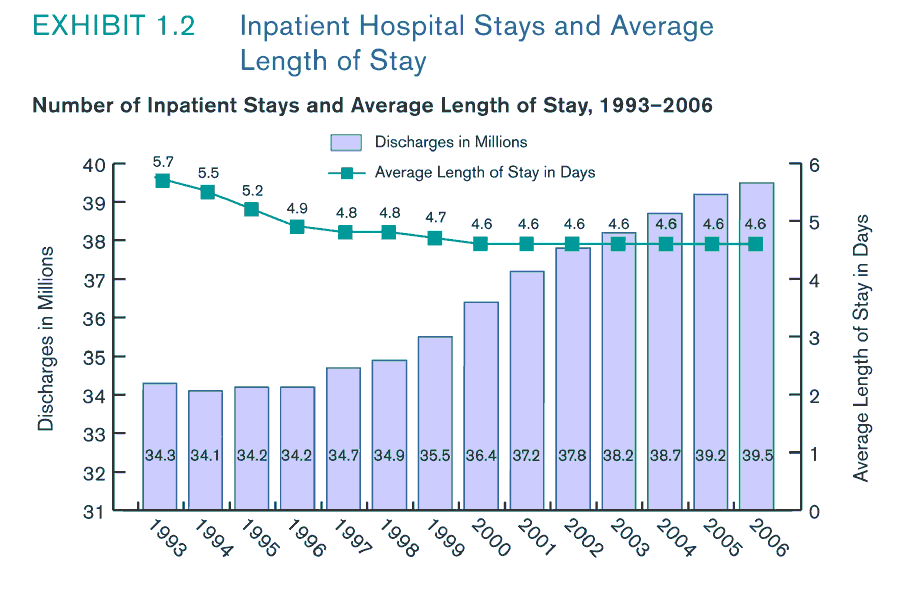
The average length of stay in U.S. community hospitals stabilized beginning in 2000, while the number of hospital stays continued to slowly rise.
- The average length of stay (ALOS) in 2006 was 4.6 days—almost 20 percent shorter than in 1993, when the ALOS was 5.7 days. The ALOS declined throughout most of the 1990s and has remained unchanged in the current decade at 4.6 days.
- The number of discharges increased from 34.3 million in 1993 to 39.5 million in 2006.
- There were about 132 hospital stays for every 1,000 persons in the United States in 2006, approximately the same number as in 1993.
- From 1993 to 1998, the number of discharges grew very slowly, increasing by only 0.6 million.
- Growth in the number of discharges (an average of 0.3 percent annually) did not keep pace with the growth in population (1.2 percent annually).
- It is likely that rapid growth in the adoption of managed care plans and the shift to outpatient (ambulatory) care slowed growth in inpatient hospital utilization.
- However, from 1998 through 2005, the number of discharges rose by 4.3 million.2 Growth in the number of discharges (an average of 1.6 percent annually) exceeded population growth (1.1 percent annually).
- The number of discharges between 2005 and 2006 rose just 0.7 percent, slower than the growth in population (0.9 percent).
2From 1998 to 2001, low unemployment and the need for employers to attract and retain workers through generous health benefits produced a loosening of care management by insurance plans. Forest S, Goetghebeur M, Hay J. Forces Influencing Inpatient Hospital Costs in the United States. Chicago: Blue Cross Blue Schield Association. 2002.
EXHIBIT 1.3 Reasons for Hospital Stays
(text version)

- Circulatory conditions were the most frequent major cause of hospital stays in 2006, accounting for 16 percent of all hospital stays. These stays were for diagnoses such as coronary artery disease, congestive heart failure, heart attack, and irregular heart beat.
- Pregnancy and childbirth (12 percent) and newborns (11 percent) ranked second and third among reasons for hospitalizations and, combined, were responsible for one out of four stays in hospitals.
- Together with respiratory conditions (10 percent of all discharges) and digestive conditions (9 percent of all discharges), the top five major reasons for hospital stays accounted for 58 percent of all discharges.
- Males accounted for 16.3 million stays in 2006 or 41 percent of all hospitalizations.
- Of these stays, 21 percent were for circulatory conditions, 14 percent were for newborns, 11 percent were for respiratory conditions, and 9 percent involved conditions of the digestive system.
- These four major conditions amounted to 55 percent of all hospitalizations for males.
- Females experienced 23.1 million hospitalizations in 2006, or 6.8 million more stays than males. About 59 percent of all hospitalizations involved females.
- Even when pregnancy and childbirth stays are excluded, females accounted for more stays than males—18.3 million stays for females compared to 16.3 million stays for males.
- Pregnancy and childbirth was the reason for 2 out of every 10 female hospitalizations.
- About 9 percent of female stays in the hospital were newborns.
- Other major reasons for female hospitalizations were related to the circulatory system (13 percent), respiratory system (9 percent), and digestive system (8 percent).
- If pregnancy and childbirth are excluded, the largest differences between males and females in reasons for hospitalization were for diseases of the circulatory system, which accounted for 3.4 million male hospital stays, but only 3.0 million female stays, and diseases of the digestive system, which accounted for 1.9 million female stays, but only 1.5 million male stays.
(text version)
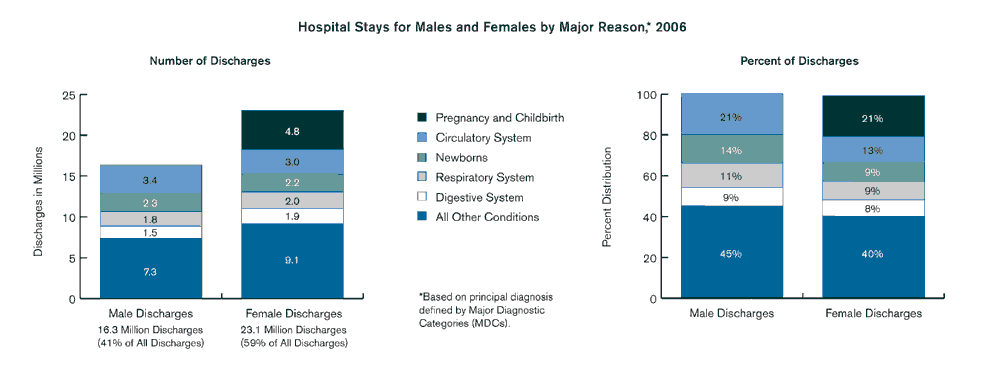
EXHIBIT 1.4 Expected Primary Payer
(text version)
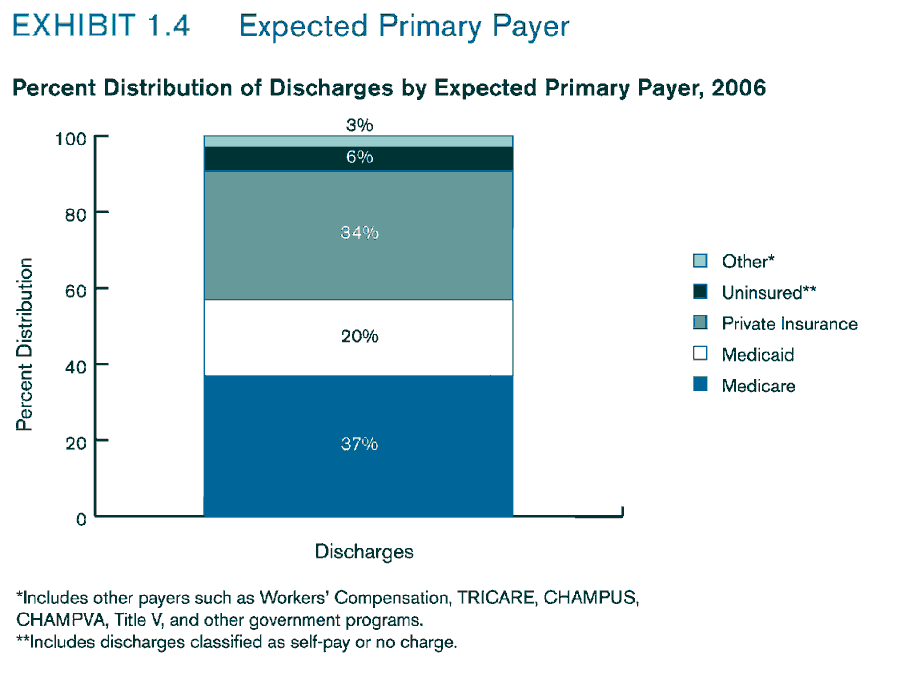
(text version)

The expected primary payer bears the major financial responsibility for the hospital stay. However, other payers, including the patients themselves, may also pay part of the cost of hospitalization.
- Medicare and Medicaid together assumed primary financial responsibility for 57 percent of all hospital stays in 2006.
- Medicare was the expected primary payer for 37 percent of all inpatient hospital discharges (14.7 million hospital stays). Medicare patients are 65 and older or disabled.
- Medicaid was the expected primary payer for 1 out of every 5 hospital stays (20 percent or 7.7 million discharges). These may include stays for patients covered by the State Children's Health Insurance Program (SCHIP), depending on the state in which the hospital was located.
- Private insurance was the expected primary payer for 34 percent of all discharges (13.4 million hospital stays). These stays were primarily for employed persons and their families who receive health insurance coverage through their employers.
- Approximately 6 percent of all stays (2.2 million discharges) were listed as uninsured.
- Other payers accounted for 3 percent of all stays in 2006.
Between 1997 and 2006, the number of hospital discharges grew by 14 percent; however, the growth varied widely by expected primary payer.
- Medicaid discharges grew by 36 percent and uninsured discharges grew at nearly the same rate—34 percent. These rates are more than twice the rate of growth of all discharges.
- The number of discharges for which Medicare was the primary payer grew at close to the same rate as the all-payer discharge rate (17 percent for Medicare and 14 percent for all discharges).
- The number of discharges covered primarily by private insurance did not change between 1997 and 2006.
EXHIBIT 1.5 Admission Source
(text version)
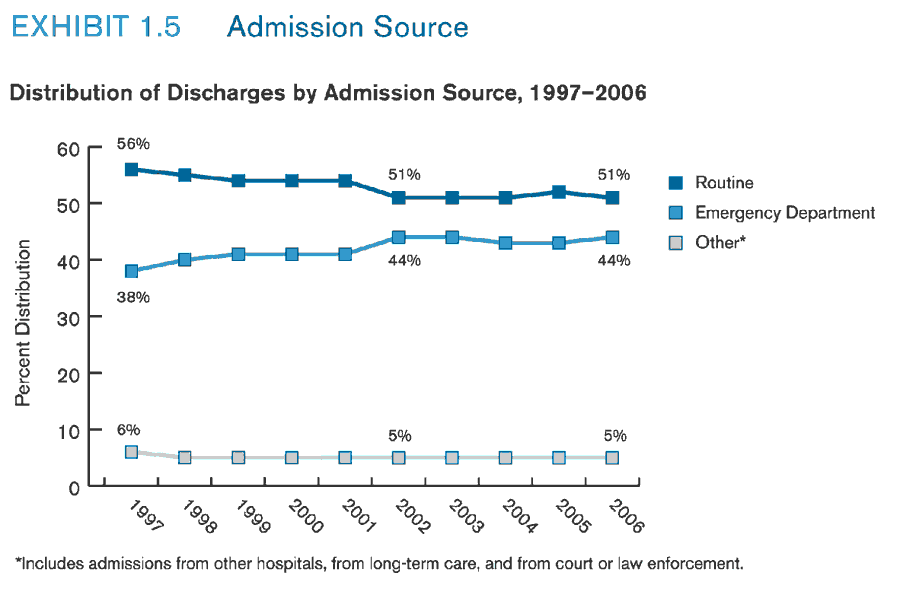
Admission source indicates routine admission and other specific settings where the patient was located prior to admission to the hospital.
- The majority of hospital admissions were routine—non–emergency admissions from home, via a physician or clinic referral, or due to birth. However, these admissions made up a smaller share of all admissions by 2006 (51 percent) than they did in 1997 (56 percent).
- Emergency departments accounted for 38 percent of all hospital admissions in 1997. By 2002 these admissions accounted for 44 percent of all admissions, a share that remained relatively stable through 2006.
- The portion of admissions from other sources (short-term hospitals, long-term care facilities, court and other law enforcement facilities, and other sources) remained between 5 and 6 percent from 1997 through 2006.
EXHIBIT 1.6 Discharge Status
(text version)
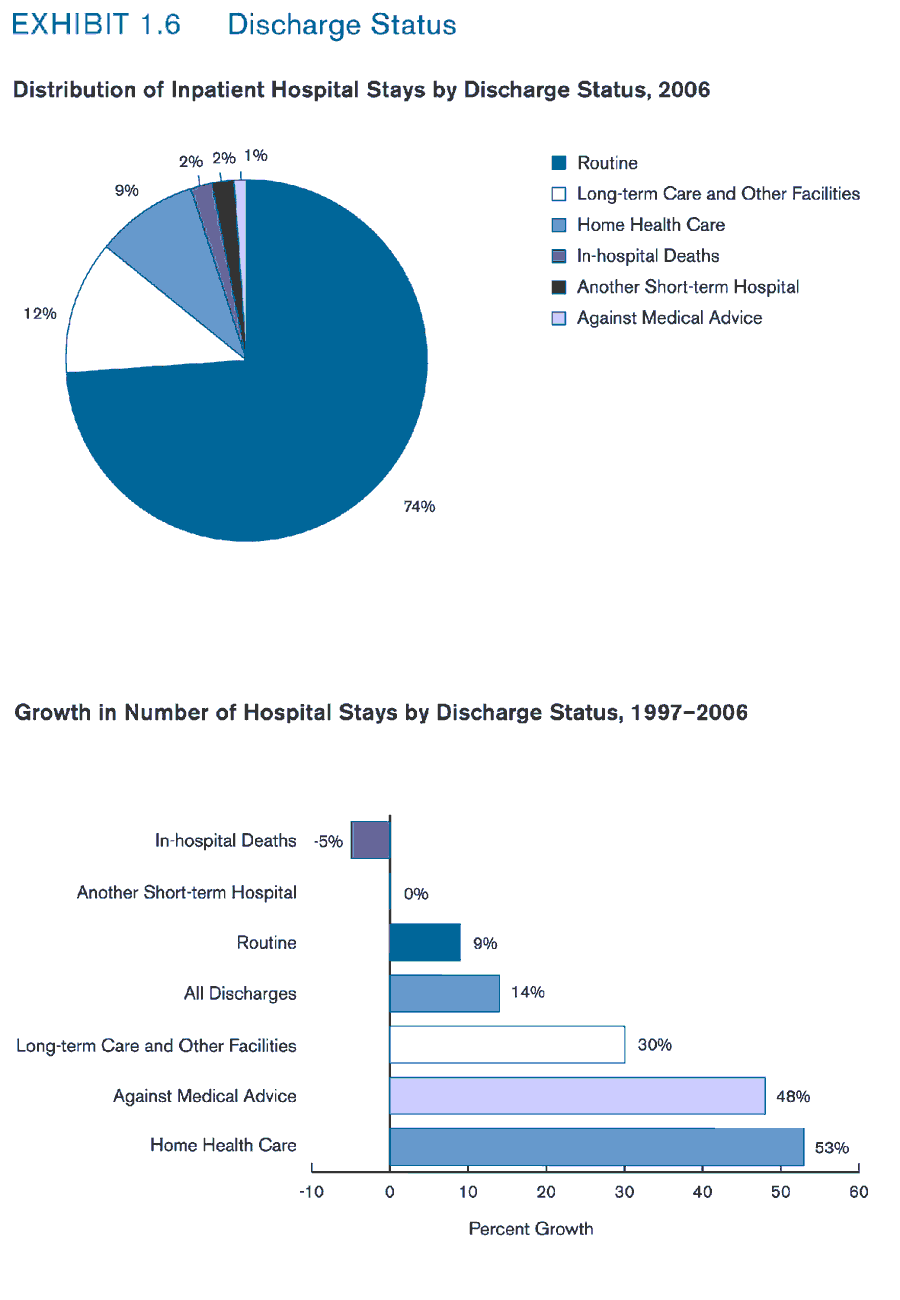
Discharge status indicates the circumstance surrounding the discharge or where the patient went after discharge from the hospital. Most discharges were routine in nature, but discharges to follow-on care were also frequent.
- The most common patient discharge status was routine (74 percent), with the patient being sent home without closely supervised healthcare.
- Discharge to a long-term care facility was the second most common type of discharge, accounting for 12 percent of discharges.
- Discharge to the home with home healthcare supervision accounted for 9 percent of discharges.
- Remaining discharge circumstances (in-hospital death, to another short-term hospital, or when the patient leaves against medical advice) each accounted for 2 percent or less of discharges.
The number of discharges increased by 14 percent from 1997 to 2006, but growth varied by discharge status.
- The number of discharges to home health grew by 53 percent.
- The number of patients who left the hospital against medical advice, although small, rose by 48 percent—the second fastest increase of any discharge type.
- Discharges to nursing homes and long term care increased by 30 percent.
- The number of in-hospital deaths decreased by 5 percent.
(text version)

(text version)
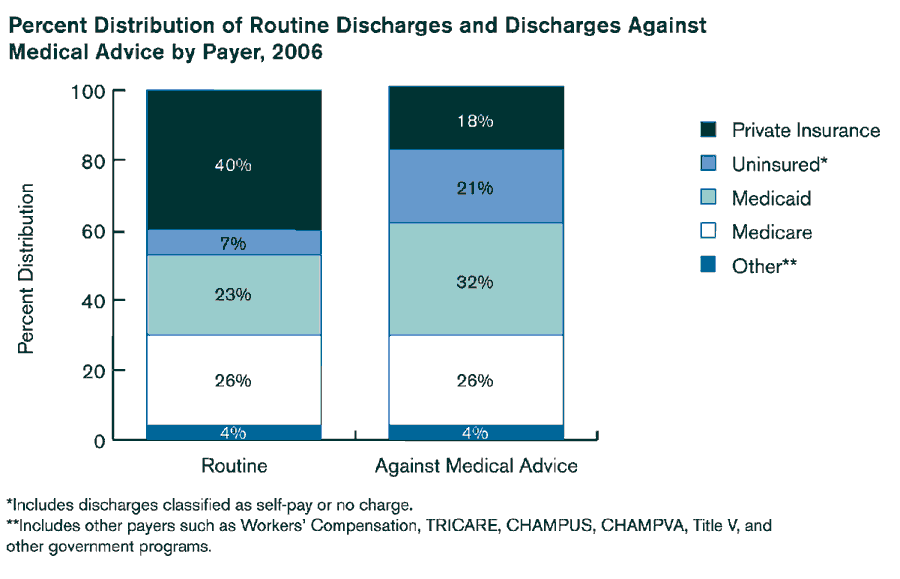
Compared with routine discharges, hospital stays that ended in a discharge against medical advice had a different distribution of expected payers.
- Only 18 percent of patients discharged against medical advice were privately insured, compared to 40 percent of routine discharges.
- Persons discharged against medical advice were more likely to be uninsured or to have Medicaid as their primary expected payer than those who were discharged routinely.
- About 21 percent of patients discharged against medical advice were uninsured, compared to 7 percent of routine discharges.
- Similarly, 32 percent of patients discharged against medical advice were covered by Medicaid, compared to 23 percent of routine discharges.
- There was no difference in the distribution of Medicare and other payer discharges between patients who were discharged routinely and those who were discharged against medical advice.
EXHIBIT 1.7 Patient Age
(text version)

(text version)
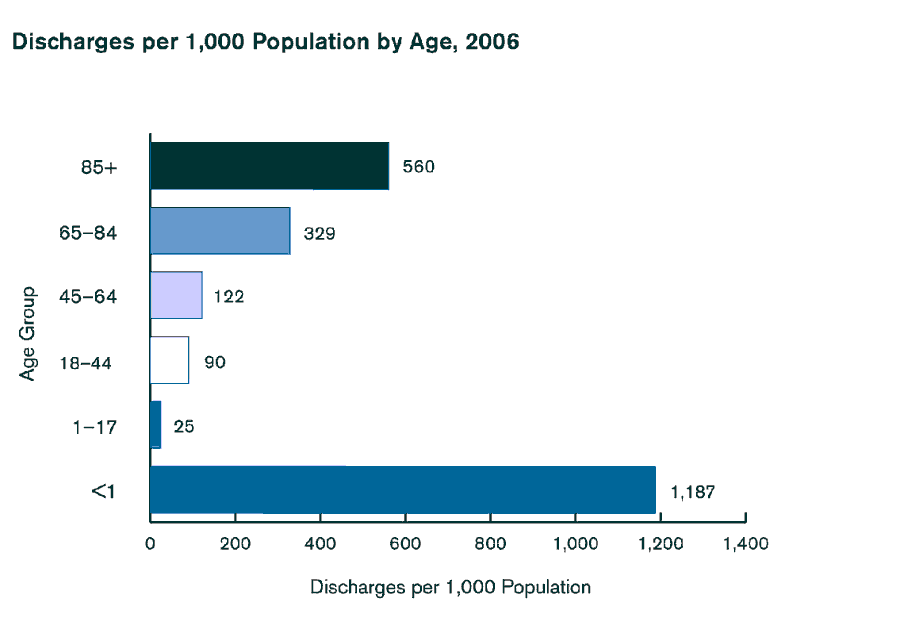
Older people account for a disproportionately larger share of hospitalizations compared to other age groups.
- While people ages 65 and older represented 13 percent of the population in 2006, they comprised 34 percent of the hospitalizations.
- The younger patient age groups had a lower proportion of hospitalizations relative to their representation in the population.
- Patients 18-64 years of age, at 63 percent of the population, accounted for 49 percent of hospitalizations.
- Those under age 18, at 25 percent of the population, accounted for 17 percent of hospitalizations.
Discharges for an age group divided by the number of people in that age group (discharges per 1,000 population) show that older age is associated with a greater chance of hospitalization.
- Across all age groups, there were an average of 132 discharges for every 1,000 persons in the United States in 2006.
- While there were only 25 hospital stays for every 1,000 children ages 1 to 17 in 2006, there were 560 stays for every 1,000 adults ages 85 and above.
- The one exception to this pattern was for infants younger than 1 year of age. This group experienced 1,187 hospitalizations per 1,000 infants, because nearly all births occur in the hospital and some infants require additional hospitalization in the first year of life.
INPATIENT HOSPITAL STAYS BY DIAGNOSIS
Number of Discharges, Percent Distribution, Rank, and Growth of the Most Frequent Principal Diagnoses for Inpatient Hospital Stays, 1997, 2005, and 2006
| PRINCIPAL CCS DIAGNOSIS |
NUMBER OF DISCHARGES IN THOUSANDS |
PERCENT OF DISCHARGES |
RANK |
GROWTH |
| 1997 |
2005 |
2006 |
1997 |
2005 |
2006 |
1997 |
2005 |
2006 |
1997-2006 |
| All discharges |
34,679 |
39,164 |
39,450 |
100.0% |
100.0% |
100.0% |
|
|
|
14% |
| Pregnancy, childbirth, and newborn infants |
8,236 |
9,145 |
9,252 |
23.7 |
23.4 |
23.5 |
1 |
1 |
1 |
12 |
| Pneumonia |
1,232 |
1,355 |
1,218 |
3.6 |
3.5 |
3.1 |
3 |
2 |
2 |
-1 |
| Coronary atherosclerosis (coronary artery disease) |
1,407 |
1,110 |
1,198 |
4.1 |
2.8 |
3.0 |
2 |
3 |
3 |
-15 |
| Congestive heart failure |
991 |
1,090 |
1,099 |
2.9 |
2.8 |
2.8 |
4 |
4 |
4 |
11 |
| Non-specific chest pain |
538 |
825 |
857 |
1.6 |
2.1 |
2.2 |
10 |
5 |
5 |
59 |
| Cardiac dysrhythmias (irregular heart beat) |
572 |
697 |
749 |
1.7 |
1.8 |
1.9 |
8 |
8 |
6 |
31 |
| Osteoarthritis (degenerative joint disease) |
418 |
738 |
735 |
1.2 |
1.9 |
1.9 |
17 |
6 |
7 |
76 |
| Mood disorders (depression and bipolar disorders) |
641 |
713 |
729 |
1.8 |
1.8 |
1.8 |
6 |
7 |
8 |
14 |
| Acute myocardial infarction (heart attack) |
732 |
662 |
675 |
2.1 |
1.7 |
1.7 |
5 |
9 |
9 |
-8 |
| Disorders of intervertebral discs and bones in spinal column (back problems) |
536 |
647 |
636 |
1.5 |
1.7 |
1.6 |
11 |
10 |
10 |
19 |
| Complication of device, implant or graft |
491 |
616 |
634 |
1.4 |
1.6 |
1.6 |
12 |
12 |
11 |
29 |
| Septicemia (blood infection) |
413 |
538 |
611 |
1.2 |
1.4 |
1.5 |
18 |
15 |
12 |
48 |
| Chronic obstructive lung disease |
551 |
630 |
598 |
1.6 |
1.6 |
1.5 |
9 |
11 |
13 |
8 |
| Skin and subcutaneous tissue infections |
330 |
582 |
597 |
1.0 |
1.5 |
1.5 |
24 |
13 |
14 |
81 |
| Acute cerebrovascular disease (stroke) |
616 |
526 |
537 |
1.8 |
1.3 |
1.4 |
7 |
17 |
15 |
-13 |
In 2006, there were 39.5 million hospital stays, an increase of 14 percent since 1997. The 15 most frequently occurring principal diagnoses accounted for just over half of all discharges in 2006. Twelve of the 15 most frequent principal diagnoses in 2006 were among the most frequent diagnoses in 1997.
Among all discharges:
- Conditions related to pregnancy, childbirth, and newborn infants were by far the most frequent reason for hospitalizations, accounting for 23.5 percent of discharges (nearly one in four) in 2006, and were unchanged in rank across the years.
- Pneumonia and coronary artery disease (coronary atherosclerosis) were the second and third most common principal diagnoses, at 3.1 percent and 3.0 percent of discharges in 2006, respectively.
- Circulatory diseases accounted for 6 of the top 15 most frequent principal diagnoses in 2006.
- The volume of stays for congestive heart failure, non-specific chest pain, and irregular heart beat increased between 1997 and 2006.
- The volume of stays for coronary artery disease (coronary atherosclerosis), heart attacks, and stroke remained statistically unchanged or declined over the same period.
- The number of hospitalizations grew rapidly between 1997 and 2006 for some conditions:
- Skin and subcutaneous tissue infections were up 81 percent and septicemia increased by 48 percent.
- Degenerative joint disease (osteoarthritis) increased by 76 percent.
- Non-specific chest pain rose by 59 percent. Many patients admitted to evaluate possible heart attack receive this diagnosis when the source of the pain cannot be determined.
Number of Discharges, Percent Distribution, Rank, and Growth of the Most Frequent Principal Diagnoses for Maternal and Infant Inpatient Hospital Stays, 1997, 2005, and 2006
| PRINCIPAL CCS DIAGNOSIS |
NUMBER OF DISCHARGES IN THOUSANDS |
PERCENT OF DISCHARGES |
RANK |
GROWTH |
| 1997 |
2005 |
2006 |
1997 |
2005 |
2006 |
1997 |
2005 |
2006 |
1997-2006 |
| All maternal discharges* |
4,338 |
4,716 |
4,796 |
100.0% |
100.0% |
100.0% |
|
|
|
11% |
| Trauma to external female genitals (vulva) and area between anus and vagina (perineum) due to childbirth |
713 |
784 |
818 |
16.4 |
16.6 |
17.1 |
1 |
1 |
1 |
15 |
| Previous C-section |
271 |
481 |
505 |
6.3 |
10.2 |
10.5 |
3 |
2 |
2 |
86 |
| Normal pregnancy and/or delivery |
544 |
325 |
315 |
12.5 |
6.9 |
6.6 |
2 |
3 |
3 |
-42 |
| Prolonged pregnancy |
§ |
234 |
242 |
§ |
5.0 |
5.0 |
§ |
6 |
4 |
§ |
| Early or threatened labor |
261 |
236 |
239 |
6.0 |
5.0 |
5.0 |
4 |
4 |
5 |
-9 |
| Hypertension complicating pregnancy, childbirth and the puerperium (high blood pressure during pregnancy) |
185 |
220 |
225 |
4.3 |
4.7 |
4.7 |
7 |
7 |
6 |
22 |
| Fetal distress and abnormal forces of labor |
§ |
234 |
223 |
§ |
5.0 |
4.6 |
§ |
5 |
7 |
§ |
| Umbilical cord complication |
259 |
217 |
220 |
6.0 |
4.6 |
4.6 |
5 |
8 |
8 |
-15 |
| Polyhydramnios and other problems of amniotic cavity (excess amniotic fluid and other problems of amniotic cavity) |
202 |
191 |
190 |
4.7 |
4.1 |
4.0 |
6 |
9 |
9 |
-6 |
| |
| All infant discharges |
3,898 |
4,429 |
4,456 |
100.0% |
100.0% |
100.0% |
|
|
|
14% |
| Liveborn (newborn infant) |
3,777 |
4,228 |
4,289 |
96.9 |
95.5 |
96.2 |
1 |
1 |
1 |
14 |
| Other perinatal conditions (other conditions occurring around the time of birth) |
56 |
94 |
82 |
1.4 |
2.1 |
1.8 |
2 |
2 |
2 |
46 |
| Hemolytic jaundice and perinatal jaundice (infant jaundice following birth) |
33 |
57 |
46 |
0.8 |
1.3 |
1.0 |
3 |
3 |
3 |
40 |
| Short gestation, low birth weight, and fetal growth retardation (premature birth and low birth weight) |
22 |
31 |
26 |
0.6 |
0.7 |
0.6 |
4 |
4 |
4 |
15 |
| Infant respiratory distress syndrome |
8 |
16 |
12 |
0.2 |
0.4 |
0.3 |
5 |
5 |
5 |
46 |
| Birth trauma |
1 |
1 |
1 |
0.0 |
0.0 |
0.0 |
7 |
6 |
6 |
10 |
| Intrauterine hypoxia and birth asphyxia (lack of oxygen to baby in uterus or during birth) |
1 |
1 |
1 |
0.0 |
0.0 |
0.0 |
6 |
7 |
7 |
-32 |
* Includes additional maternal CCS diagnoses not shown on this table but listed in the Sources and Methods of this report.
§ Consistent data is not available for this diagnosis due to coding changes that took place between 1997 and 2005. |
There were 4.8 million maternal discharges in 2006, an 11-percent increase since 1997. Not all of these maternal discharges involved the birth of an infant; some dealt with complications during pregnancy. There were also 4.5 million infant discharges, a 14-percent increase since 1997.1
Among maternal discharges:
- Stays for normal pregnancy declined by 42 percent from 1997 to 2006. More maternal stays in 2006 had a principal diagnosis that indicated some problem in pregnancy or delivery than in 1997.
- The principal diagnosis of previous C-section increased 86 percent between 1997 and 2006.
- Stays with a principal diagnosis of high blood pressure during pregnancy increased by 22 percent between 1997 and 2006.
- Declines were seen for: umbilical cord complications (-15 percent), early or threatened labor (-8 percent), and excess amniotic fluid and other problems of the amniotic cavity (-6 percent).
Among infant discharges:
- Almost all infant discharges in 2006 (96 percent) had a principal diagnosis of "newborn infant."
- Some conditions such as infant jaundice and infant respiratory distress syndrome increased 40 percent or more between 1997 and 2006.
1Only principal diagnoses (the main reason for the hospital stay) are listed in this exhibit. The table provides information on the number of discharges, assigning one diagnosis to each hospital stay based on the principal diagnosis. The number of cases and growth rates for specific maternal and infant conditions may differ from those shown in Exhibit 5.1, which shows all-listed diagnoses (principal plus all secondary conditions) for childbirth and newborn stays.
Number of Discharges, Percent Distribution, and Growth of the Most Frequent Principal Diagnoses for Inpatient Hospital Stays by Age, 1997, 2005, and 2006
| AGE GROUP AND PRINCIPAL CCS DIAGNOSIS |
NUMBER OF DISCHARGES IN THOUSANDS |
PERCENT OF AGE-SPECIFIC TOTAL DISCHARGES |
GROWTH |
| 1997 |
2005 |
2006 |
1997 |
2005 |
2006 |
1997-2006 |
| All ages, total discharges† |
34,679 |
39,164 |
39,450 |
|
|
|
14% |
| ‹ 1 year, total discharges |
4,426 |
4,978 |
4,908 |
100.0% |
100.0% |
100.0% |
11 |
| Liveborn (newborn infant) |
3,776 |
4,223 |
4,284 |
85.3 |
84.8 |
87.3 |
13 |
| Acute bronchitis |
108 |
107 |
102 |
2.4 |
2.2 |
2.1 |
-6 |
| Hemolytic jaundice and perinatal jaundice (infant jaundice following birth) |
33 |
56 |
46 |
0.7 |
1.1 |
0.9 |
40 |
| Pneumonia |
55 |
43 |
39 |
1.3 |
0.9 |
0.8 |
-29 |
| Short gestation, low birth weight, and fetal growth retardation (premature birth and low birth weight) |
22 |
31 |
26 |
0.5 |
0.6 |
0.5 |
15 |
| 1-17 years, total discharges |
1,821 |
2,059 |
1,711 |
100.0 |
100.0 |
100.0 |
-6 |
| Asthma |
159 |
139 |
122 |
8.7 |
6.8 |
7.1 |
-23 |
| Pneumonia |
135 |
142 |
116 |
7.4 |
6.9 |
6.8 |
-14 |
| Appendicitis and other appendiceal conditions |
65 |
90 |
80 |
3.6 |
4.3 |
4.7 |
23 |
| Fluid and electrolyte disorders (primarily dehydration or fluid overload) |
64 |
98 |
74 |
3.5 |
4.8 |
4.3 |
15 |
| Mood disorders (depression and bipolar disorders) |
64 |
73 |
62 |
3.5 |
3.6 |
3.6 |
-3 |
| 18-44 years, total discharges |
9,444 |
10,041 |
10,212 |
100.0 |
100.0 |
100.0 |
8 |
| Trauma to external female genitals (vulva) and area between anus and vagina (perineum), due to childbirth |
676 |
753 |
785 |
7.2 |
7.5 |
7.7 |
16 |
| Previous C-section |
270 |
478 |
502 |
2.9 |
4.8 |
4.9 |
86 |
| Mood disorders (depression and bipolar disorder) |
335 |
364 |
375 |
3.5 |
3.6 |
3.7 |
12 |
| Normal pregnancy and/or delivery |
511 |
312 |
303 |
5.4 |
3.1 |
3.0 |
-41 |
| Prolonged pregnancy |
§ |
224 |
231 |
§ |
2.2 |
2.3 |
§ |
| 45-64 years, total discharges |
6,496 |
8,660 |
9,100 |
100.0 |
100.0 |
100.0 |
40 |
| Coronary atherosclerosis (coronary artery disease) |
526 |
461 |
501 |
8.1 |
5.3 |
5.5 |
-5 |
| Non-specific chest pain |
242 |
388 |
408 |
3.7 |
4.5 |
4.5 |
69 |
| Osteoarthritis (degenerative joint disease) |
105 |
272 |
281 |
1.6 |
3.1 |
3.1 |
167 |
| Disorders of intervertebral discs and bones in spinal column (back problems) |
190 |
266 |
269 |
2.9 |
3.1 |
3.0 |
42 |
| Pneumonia |
199 |
271 |
260 |
3.1 |
3.1 |
2.9 |
31 |
| 65-84 years, total discharges |
10,121 |
10,449 |
10,512 |
100.0 |
100.0 |
100.0 |
4 |
| Coronary atherosclerosis (coronary artery disease) |
741 |
541 |
584 |
7.3 |
5.2 |
5.6 |
-21 |
| Congestive heart failure |
581 |
571 |
559 |
5.7 |
5.5 |
5.3 |
-4 |
| Pneumonia |
514 |
550 |
494 |
5.1 |
5.3 |
4.7 |
-4 |
| Osteoarthritis (degenerative joint disease)) |
281 |
419 |
406 |
2.8 |
4.0 |
3.9 |
44 |
| Cardiac dysrhythmias (irregular heart beat) |
333 |
366 |
392 |
3.3 |
3.5 |
3.7 |
18 |
| 85+ years, total discharges |
2,362 |
2,926 |
2,970 |
100.0 |
100.0 |
100.0 |
26 |
| Congestive heart failure |
202 |
244 |
250 |
8.6 |
8.4 |
8.4 |
24 |
| Pneumonia |
197 |
231 |
203 |
8.3 |
7.9 |
6.8 |
3 |
| Fracture of neck of femur (hip fracture) |
125 |
123 |
119 |
5.3 |
4.2 |
4.0 |
-5 |
| Septicemia (blood infection) |
76 |
103 |
115 |
3.2 |
3.5 |
3.9 |
51 |
| Urinary tract infections |
75 |
111 |
114 |
3.2 |
3.8 |
3.9 |
53 |
† Includes a small number of discharges (less than 38,000 or 0.1 percent) with missing age.
§ Consistent data is not available for this diagnosis due to coding changes that took place between 1997 and 2005.
|
The top five principal diagnoses for hospitalizations generally varied by age. Older patients were more frequently admitted with cardiovascular and musculoskeletal conditions and younger patients were more frequently admitted with pregnancy- and childbirth-related conditions. The largest increase in hospitalizations occurred for 45-64 year olds (up 40 percent) and adults 85 and older (up 26 percent).
- Pneumonia was a top five condition for all age groups except 18-44 year olds in 1997-2006.
- Asthma and pneumonia were the most common reasons for hospital admission among children ages 1-17 in 1997-2006.
- Depression and bipolar disorders (mood disorders) were among the most common diagnoses for children ages 1-17 and adults ages 18-44 in 1997-2006.
- Of the most frequent diagnoses for adults ages 18-44, all except one (mood disorders) were related to pregnancy and delivery in 1997-2006.
- Cardiovascular conditions were the most common diagnoses for adults ages 45 and above. However, specific diagnoses differed somewhat between age groups for older adults:
- Coronary atherosclerosis (coronary artery disease) was the most frequent cardiac condition for adults ages 45-64 in 1997, 2005, and 2006 and for ages 65-84 in 1997 and 2006.
- Congestive heart failure was the most common cardiac condition for adults 85 years and older in 1997-2006.
- Degenerative joint disease (osteoarthritis) was a common diagnosis for adults ages 45-64 and ages 65-84 in 2006; it increased by 167 percent among adults ages 45-64 and by 44 percent among adults ages 65-84 between 1997 and 2006.
- Hospital stays for hip fractures, a common diagnosis among adults 85 and over, changed very little between 1997 and 2006.
- Among adults 85 and over, hospitalizations for septicemia (up 51 percent) and urinary tract infections (up 53 percent) increased at twice the rate of all hospitalizations for this age group between 1997 and 2006.
Number of Discharges, Percent Distribution, and Rank of the Most Frequent Principal Diagnoses for Inpatient Hospital Stays by Sex, 2006
| PRINCIPAL CCS DIAGNOSIS |
MALES |
FEMALES |
PERCENT OF PRINCIPAL DIAGNOSIS TOTAL DISCHARGES |
| NUMBER OF DISCHARGES IN THOUSANDS |
PERCENT OF MALE DISCHARGES |
RANK |
NUMBER OF DISCHARGES IN THOUSANDS |
PERCENT OF FEMALE DISCHARGES |
RANK |
MALES |
FEMALES |
| All diagnoses† |
16,296 |
100.0% |
|
23,052 |
100.0% |
|
41% |
59% |
| Pregnancy and childbirth |
|
|
|
4,785 |
20.8 |
1 |
|
|
| Liveborn (newborn infant) |
2,191 |
13.4 |
1 |
2,090 |
9.1 |
2 |
51 |
49 |
| Coronary atherosclerosis (coronary artery disease) |
747 |
4.6 |
2 |
451 |
2.0 |
6 |
62 |
38 |
| Pneumonia |
583 |
3.6 |
3 |
633 |
2.7 |
3 |
48 |
52 |
| Congestive heart failure |
534 |
3.3 |
4 |
565 |
2.4 |
4 |
49 |
51 |
| Acute myocardial infarction (heart attack) |
406 |
2.5 |
5 |
269 |
1.2 |
20 |
60 |
40 |
| Non-specific chest pain |
379 |
2.3 |
6 |
477 |
2.1 |
5 |
44 |
56 |
| Cardiac dysrhythmias (irregular heart beat) |
369 |
2.3 |
7 |
379 |
1.6 |
10 |
49 |
51 |
| Complication of medical device, implant or graft |
327 |
2.0 |
8 |
307 |
1.3 |
16 |
52 |
48 |
| Skin and subcutaneous tissue infections |
319 |
2.0 |
9 |
276 |
1.2 |
19 |
54 |
46 |
| Mood disorders (depression and bipolar disorders) |
310 |
1.9 |
10 |
418 |
1.8 |
8 |
43 |
57 |
| Osteoarthritis (degenerative joint disease) |
281 |
1.7 |
13 |
451 |
2.0 |
7 |
38 |
62 |
| Urinary tract infections |
149 |
0.9 |
28 |
382 |
1.7 |
9 |
28 |
72 |
| † Excludes a small number of discharges (less than 103,000 or 0.3 percent) with missing sex. |
The top ten most frequent conditions for men and women in the hospital were responsible for almost 40 percent of all stays for men and 50 percent of all stays for women. Most diagnoses are common to both males and females, if those related to childbirth are excluded. However, some diagnoses were more frequent in one sex.
- Females accounted for almost 6 out of every 10 hospital stays—23.1 million stays in 2006. About 21 percent of all female hospitalizations were related to pregnancy and childbirth.
- Males accounted for 16.3 million hospitalizations in 2006.
- Five heart-related diagnoses—coronary artery disease, congestive heart failure, heart attacks, non-specific chest pain, and cardiac dysrhythmias—were among the ten most common principal diagnoses for both male and female hospitalizations.
- Coronary artery disease and heart attacks were responsible for more male than female hospitalizations in 2006. Males accounted for 62 percent of hospital stays for coronary artery disease and 60 percent of stays for heart attack.
- Congestive heart failure (534,000 stays for males and 565,000 for females) and irregular heart beat (369,000 stays for males and 379,000 for females) occurred equally often in hospitalizations for males and females.
- Non-specific chest pain was more often the reason for hospitalization for women (56 percent of stays) than for men (44 percent of stays).
- Other conditions causing many more hospitalizations for females than males included mood disorders (57 percent female), degenerative joint disease (62 percent female) and urinary tract infections (72 percent female).
- Other conditions causing more hospitalizations for males than females included skin and subcutaneous tissue infections (54 percent male).
HOSPITAL INPATIENT STAYS BY PROCEDURE
Number, Percent Distribution, Rank, and Growth of Discharges for the Most Frequent All-listed Inpatient Hospital Procedures, 1997, 2005, and 2006
| All-listed CCS Procedures |
Number of Stays with the Procedure in Thousands |
Percent of Discharges with the Procedure |
Rank |
Growth |
| 1997 |
2005 |
2006 |
1997 |
2005 |
2006 |
1997 |
2005 |
2006 |
1997-2006 |
| All discharges (with and without procedures) |
34,679 |
39,164 |
39,450 |
|
|
|
|
|
|
14% |
| All discharges with any procedure |
21,257 |
24,145 |
24,445 |
100% |
100% |
100% |
|
|
|
15 |
| Percent of all discharges with a procedure |
61% |
62% |
62% |
|
|
|
|
|
|
|
| Blood transfusion |
1,097 |
2,359 |
2,382 |
5 |
10 |
10 |
5 |
1 |
1 |
117 |
| Diagnostic cardiac catheterization, coronary arteriography (diagnostic procedure to explore the functioning of the heart) |
1,461 |
1,589 |
1,671 |
7 |
7 |
7 |
1 |
2 |
2 |
14 |
| Repair of obstetric laceration |
1,137 |
1,334 |
1,373 |
5 |
6 |
6 |
3 |
3 |
3 |
21 |
| Cesarean section (C-section) |
800 |
1,304 |
1,346 |
4 |
5 |
6 |
9 |
4 |
4 |
68 |
| Respiratory intubation and mechanical ventilation |
919 |
1,223 |
1,294 |
4 |
5 |
5 |
7 |
7 |
5 |
41 |
| Circumcision |
1,164 |
1,237 |
1,224 |
5 |
5 |
5 |
2 |
5 |
6 |
5 |
| Upper gastrointestinal endoscopy (procedure to view and biopsy the esophagus, stomach and first portion of intestine through a lighted tube) |
1,105 |
1,224 |
1,213 |
5 |
5 |
5 |
4 |
6 |
7 |
10 |
| Artificial rupture of membranes to assist delivery |
747 |
885 |
1,007 |
4 |
4 |
4 |
10 |
10 |
8 |
35 |
| Fetal monitoring |
1,002 |
911 |
958 |
5 |
4 |
4 |
6 |
9 |
9 |
-4 |
| Prophylactic vaccinations and inoculations |
567 |
954 |
945 |
3 |
4 |
4 |
14 |
8 |
10 |
67 |
| Episiotomy (surgical incision into the perineum and vagina to prevent traumatic tearing during delivery) |
866 |
444 |
393 |
4 |
2 |
2 |
8 |
22 |
24 |
-55 |
During six out of ten hospital stays in 2006, at least one procedure was performed, and this proportion has changed little since 1997. The number of discharges with procedures increased from 21.3 million in 1997 to 24.4 million in 2006, a 15 percent increase.
- The top 10 all-listed procedures performed in 2006 accounted for 55 percent of all procedures performed in that year.
- Blood transfusions occurred in one out of every ten hospital stays that included a procedure and was the most frequently performed procedure in both 2005 and 2006.
- With only two exceptions, little change occurred in the list of the top 10 procedures performed in U.S. hospitals since 1997.
- Vaccinations were added to the list of top 10 procedures, rising in rank from 14th in 1997 to 10th in 2006. These vaccinations were overwhelmingly hepatitis B immunizations for newborns.
- Episiotomy fell from the list of top 10 procedures, dropping in rank from 8th in 1997 to 24th in 2006.
- C-section was the most frequent major therapeutic (as opposed to diagnostic) procedure—performed on 1.3 million women in 2006.
- Seven of the top 10 procedures in 1997, 2005 and/or 2006 were associated with giving birth and newborns.
- Of the top-ranked maternal and newborn procedures, C-sections and vaccinations increased at the fastest pace—68 and 67 percent respectively.
- Between 1997 and 2006, the number of hospital stays with repair of current obstetric laceration and artificial rupture of membrane to assist delivery increased by 21 and 35 percent, respectively.
- The number of hospital stays in which episiotomies were performed declined at a faster rate than any of the most frequent procedures—by 55 percent from 1997 to 2006.
- There has been little change in the number of discharges for circumcision or fetal monitoring since 1997.
(text version)
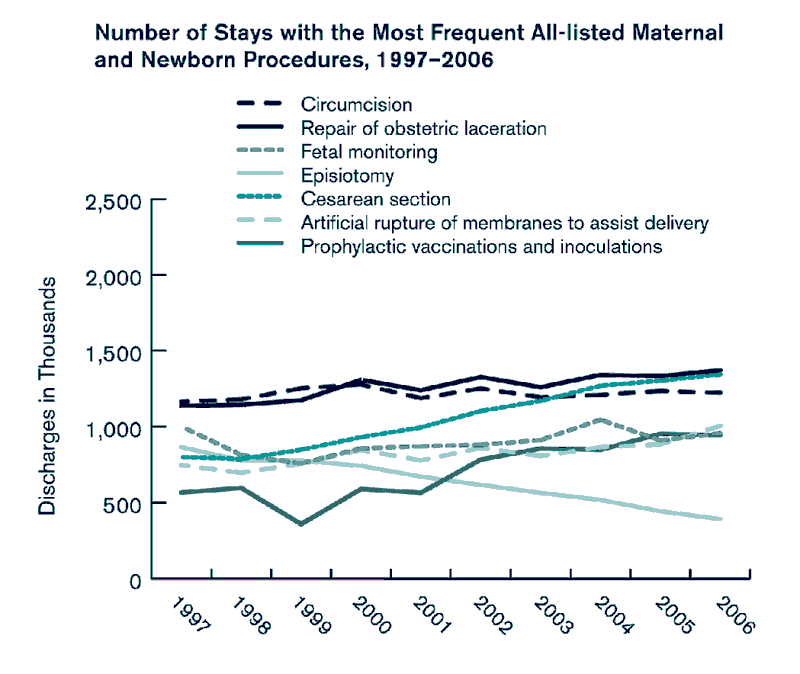
- The remaining most frequent procedures were not related to giving birth or to newborns.
- Discharges with blood transfusions have more than doubled since 1997. There were 1.1 million of stays with this procedure in 1997 and 2.4 million in 2006, an increase of 117 percent, making this the most frequent as well as the fastest growing of the most common procedures performed during a hospital stay.
- From a peak in 2001, discharges with diagnostic catheterization and coronary arteriography have remained relatively stable through 2006 while discharges with upper gastrointestinal (GI) endoscopy have fallen by 9 percent.
- Discharges with respiratory intubation and mechanical ventilation have risen steadily, from 0.9 million in 1997 to 1.3 million in 2006—a 41 percent increase.
(text version)
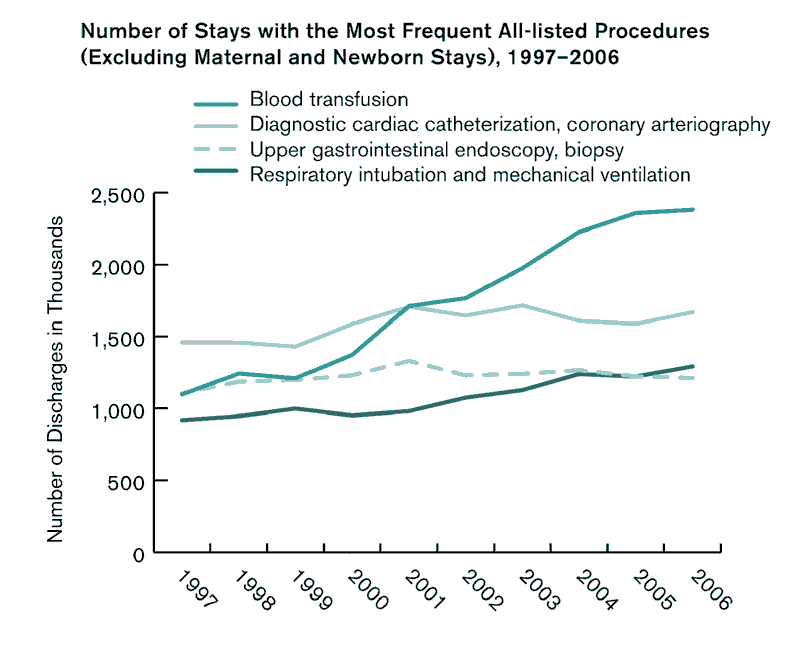
Number of Discharges, Percent Distribution, and Growth for the Most Frequent All-listed Inpatient Hospital Procedures by Age Group, 1997, 2005, and 2006
| AGE GROUP AND ALL-LISTED CCS PROCEDURES |
NUMBER OF DISCHARGES IN THOUSANDS |
PERCENT OF AGE-SPECIFIC TOTAL DISCHARGES |
GROWTH |
| 1997 |
2005 |
2006 |
1997 |
2005 |
2006 |
1997-2006 |
| All ages, total discharges† |
34,679 |
39,164 |
39,450 |
|
|
|
14% |
| ‹ 1 year, total discharges |
4,426 |
4,978 |
4,908 |
100.0 |
100.0 |
100.0 |
11 |
| Circumcision |
1,159 |
1,232 |
1,220 |
26.2 |
24.7 |
24.9 |
5 |
| Prophylactic vaccinations and inoculations |
549 |
865 |
845 |
12.4 |
17.4 |
17.2 |
54 |
| Ophthalmologic and otologic diagnosis and treatment (vision and hearing diagnosis and treatment) |
* |
471 |
406 |
* |
9.5 |
8.3 |
* |
| Respiratory intubation and mechanical ventilation |
163 |
196 |
197 |
3.7 |
3.9 |
4.0 |
21 |
| Enteral and parenteral nutrition |
39 |
101 |
106 |
0.9 |
2.0 |
2.2 |
173 |
| 1-17 years, total discharges |
1,821 |
2,059 |
1,711 |
100.0 |
100.0 |
100.0 |
-6 |
| Appendectomy (removal of appendix) |
74 |
95 |
84 |
4.1 |
4.6 |
4.9 |
13 |
| Repair of obstetric laceration |
58 |
54 |
56 |
3.2 |
2.6 |
3.3 |
-4 |
| Blood transfusion |
26 |
59 |
45 |
1.4 |
2.9 |
2.6 |
72 |
| Cancer chemotherapy |
43 |
64 |
40 |
2.4 |
3.1 |
2.3 |
-7 |
| Artificial rupture of membranes to assist delivery |
40 |
34 |
39 |
2.2 |
1.6 |
2.3 |
-4 |
| 18-44 years, total discharges |
9,444 |
10,041 |
10,212 |
100.0 |
100.0 |
100.0 |
8 |
| Repair of obstetric laceration |
1,079 |
1,278 |
1,316 |
11.4 |
12.7 |
12.9 |
22 |
| Cesarean section (C-section) |
773 |
1,270 |
1,312 |
8.2 |
12.6 |
12.8 |
70 |
| Artificial rupture of membranes to assist delivery |
706 |
850 |
968 |
7.5 |
8.5 |
9.5 |
37 |
| Fetal monitoring |
952 |
876 |
919 |
10.1 |
8.7 |
9.0 |
-3 |
| Episiotomy (surgical incision into the perineum and vagina to prevent traumatic tearing during delivery) |
813 |
418 |
370 |
8.6 |
4.2 |
3.6 |
-55 |
| 45-64 years, all discharges |
6,496 |
8,660 |
9,100 |
100.0 |
100.0 |
100.0 |
40 |
| Diagnostic cardiac catheterization, coronary arteriography (diagnostic procedure to explore the functioning of the heart) |
578 |
674 |
723 |
8.9 |
7.8 |
7.9 |
25 |
| Blood transfusion |
247 |
601 |
623 |
3.8 |
6.9 |
6.8 |
152 |
| PTCA (percutaneous transluminal coronary angioplasty, procedure involving use of a balloon-tipped catheter to enlarge a narrowed artery) |
247 |
349 |
398 |
3.8 |
4.0 |
4.4 |
61 |
| Upper gastrointestinal endoscopy (procedure to view and biopsy the esophagus, stomach and first portion of intestine through a lighted tube) |
275 |
356 |
368 |
4.2 |
4.1 |
4.0 |
34 |
| Respiratory intubation and mechanical ventilation |
186 |
310 |
348 |
2.9 |
3.6 |
3.8 |
87 |
| 65-84 years, total discharges |
10,121 |
10,449 |
10,512 |
100.0 |
100.0 |
100.0 |
4 |
| Blood transfusion |
514 |
1,059 |
1,072 |
5.1 |
10.1 |
10.2 |
109 |
| Diagnostic cardiac catheterization, coronary arteriography (diagnostic procedure to explore the functioning of the heart) |
738 |
727 |
755 |
7.3 |
7.0 |
7.2 |
2 |
| Upper gastrointestinal endoscopy (procedure to view and biopsy the esophagus, stomach and first portion of intestine through a lighted tube) |
530 |
524 |
509 |
5.2 |
5.0 |
4.8 |
-4 |
| Respiratory intubation and mechanical ventilation |
366 |
430 |
454 |
3.6 |
4.1 |
4.3 |
24 |
| PTCA (percutaneous transluminal coronary angioplasty, procedure involving use of a balloon-tipped catheter to enlarge a narrowed artery) |
286 |
376 |
426 |
2.8 |
3.6 |
4.1 |
49 |
| 85+ years, total discharges |
2,362 |
2,926 |
2,970 |
100.0 |
100.0 |
100.0 |
26 |
| Blood transfusion |
138 |
318 |
324 |
5.8 |
10.9 |
10.9 |
135 |
| Upper gastrointestinal endoscopy (procedure to view and biopsy the esophagus, stomach and first portion of intestine through a lighted tube) |
122 |
142 |
139 |
5.2 |
4.9 |
4.7 |
14 |
| Respiratory intubation and mechanical ventilation |
65 |
94 |
98 |
2.8 |
3.2 |
3.3 |
50 |
| Treatment, fracture or dislocation of hip and femur |
87 |
87 |
84 |
3.7 |
3.0 |
2.8 |
-3 |
| Colonoscopy and biopsy |
71 |
77 |
74 |
3.0 |
2.6 |
2.5 |
4 |
* Statistics based on estimates with a relative standard error (standard error/weighted estimate) greater than 0.30 or with standard error = 0 in the nationwide statistics are not reliable.
† Includes a small number of discharges (less than 38,000 or 0.1 percent) with missing age. |
The most frequent procedures tended to vary by age group.
- The most common procedures performed on infants included routine procedures, such as circumcision (performed on 24.9 percent of all infants, or 47.8 percent of all male infants) and vaccinations (performed on 17.2 percent of all infants).
- In 2006, over 1.2 million circumcisions were performed in the hospital.
- Procedures on infants also included those done for complex conditions affecting severely ill babies, such as respiratory intubation (performed on 197,000 infants in 2006) and enteral/parenteral nutrition, or tube feeding (performed on 106,000 infants in 2006). The use of tube feeding in infants increased 173 percent, nearly tripling over the past 10 years.
- Appendectomy was the most common procedure for children ages 1-17. Other top procedures included repair of obstetric laceration in teen deliveries, blood transfusion, cancer chemotherapy, and artificial rupture of membranes to assist in teen delivery.
- Pregnancy- and childbirth-related procedures accounted for all five of the most common procedures for individuals ages 18-44.
- Repair of obstetric laceration and C-sections were the most frequently performed procedures. Each of these procedures occurred in 1.3 million discharges. C-sections increased by 70 percent from 1997 to 2006, faster than any of the other top five procedures for this age group.
- Episiotomy, a surgical incision to prevent traumatic tearing during vaginal delivery, was the fifth most frequently occurring procedure in this age group. However, the number of these procedures decreased by 55 percent between 1997 and 2006.
- Other common procedures included artificial rupture of membranes to assist delivery and fetal monitoring.
- In 2006, the five most frequently performed procedures were the same for individuals ages 45-64 and ages 65-84, although their rank order differed.
- Diagnostic procedure to explore the functioning of the heart was the leading procedure for 45-64 year olds and the second most frequently performed procedure for 65-84 year olds.
- PTCA (percutaneous transluminal coronary angioplasty—a procedure involving the use of a balloon-tipped catheter to enlarge a narrowed artery) was performed in 4 percent of the hospital stays in each of these age groups.
- Other common procedures for these age groups were upper GI endoscopy and respiratory intubation/mechanical ventilation.
- For patients ages 85 and above, treatment of a fracture or dislocation of the hip and femur, and colonoscopy and biopsy were among the top 5 procedures performed during a hospital stay.
- Blood transfusion was a top five procedure in all age groups except infants less than 1 year and individuals ages 18-44. It was the third most common procedure for 1-17 year olds; second for adults ages 45-64, and first for adults 65-84 and 85 and older.
- Blood transfusion was one of the fastest growing procedures from 1997 to 2006: 72 percent increase for 1-17 year olds, 152 percent increase for 45-64 year olds, 109 percent increase for 65-84 year olds, and 135 percent increase for patients 85 and older.
Procedures were performed in 62 percent of the discharges for both males and females in 2006. In the remaining 38 percent of discharges, no procedures were performed during the hospitalizations.
For males:
- Six percent of male discharges were newborns who underwent routine procedures such as circumcision, vision and hearing (ophthalmologic and otologic) diagnosis and treatment, and/or vaccinations.
- Another 3 percent of male hospitalizations, also for newborns, received newborn procedures as well as other procedures not normally received at birth, such as respiratory intubation.
- The remaining 52 percent of discharges were not part of a newborn stay and had at least one procedure performed.
For females:
- Some of the most common procedures, performed in 21 percent of female discharges, took place during a childbirth or newborn stay.
- Eight percent of female discharges received only procedures commonly performed for childbirth or as a newborn. In addition to the newborn procedures, these included maternal procedures such as episiotomy, Cesarean section, and fetal monitoring.
- Another 13 percent of discharges involved a maternal or newborn procedure, and also involved at least one procedure not routinely performed during childbirth or on newborns, such as blood transfusion.
- The remaining 41 percent of female hospitalizations were not childbirth or newborn related. During each of these stays, one or more non-childbirth or non-newborn related procedures were performed.
(text version)
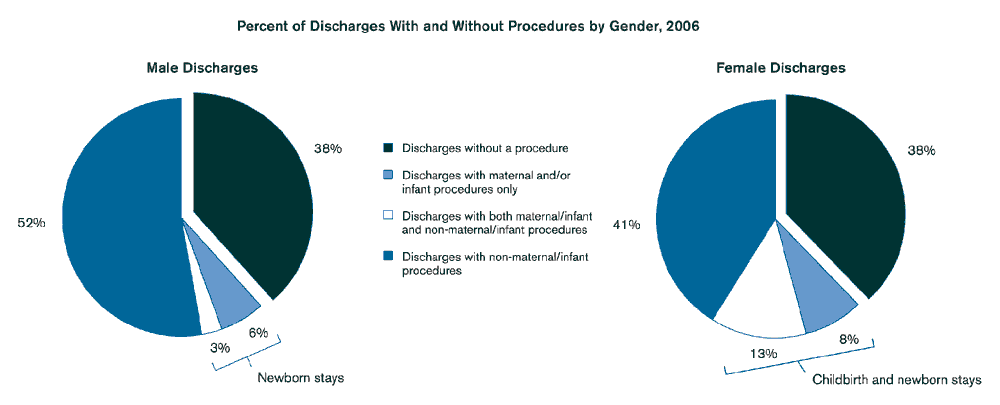
Number of Discharges, Percent Distribution, and Rank of the Most Frequent All-listed Procedures for Inpatient Hospital Stays Excluding Pregnancy and Childbirth, by Sex, 2006
| ALL-LISTED CCS PROCEDURES |
NUMBER OF DISCHARGES IN THOUSANDS |
PERCENT OF DISCHARGES WITH A PROCEDURE |
RANK |
| MALES |
FEMALES |
MALES |
FEMALES |
MALES |
FEMALES |
| Discharges with a procedure† |
8,999 |
12,476 |
100% |
100% |
|
|
| Blood transfusion |
1,024 |
1,358 |
11 |
11 |
1 |
1 |
| Diagnostic cardiac catheterization, coronary arteriography (diagnostic procedure to explore the functioning of the heart) |
1,017 |
654 |
11 |
5 |
2 |
3 |
| Respiratory intubation and mechanical ventilation |
690 |
603 |
8 |
5 |
3 |
4 |
| PTCA (percutaneous transluminal coronary angioplasty, procedure involving use of a balloon-tipped catheter to enlarge a narrowed artery) |
599 |
308 |
7 |
2 |
4 |
13 |
| Upper gastrointestinal endoscopy (procedure to view and biopsy the esophagus, stomach and first portion of intestine through a lighted tube) |
547 |
666 |
6 |
5 |
5 |
2 |
| Hemodialysis (dialysis, cleaning the blood by means of a machine or filter to compensate for poor kidney function) |
397 |
369 |
4 |
3 |
6 |
8 |
| Echocardiogram (diagnostic ultrasound of heart) |
376 |
346 |
4 |
3 |
7 |
12 |
| Alcohol and drug rehabilitation/detoxification |
275 |
116 |
3 |
1 |
8 |
37 |
| Enteral and parenteral nutrition |
265 |
269 |
3 |
2 |
9 |
17 |
| Colonoscopy and biopsy |
249 |
357 |
3 |
3 |
10 |
9 |
| Arthroplasty knee |
205 |
346 |
2 |
3 |
17 |
11 |
| Hysterectomy (removal of the uterus) |
- |
549 |
- |
4 |
- |
5 |
| Oophorectomy, unilateral and bilateral (removal of an ovary or ovaries) |
- |
407 |
- |
3 |
- |
6 |
| † Excludes procedures related to pregnancy and childbirth and a small number of discharges (less than 103,000 or 0.3 percent) with missing sex. |
(text version)

Most procedures unrelated to childbirth and newborns are the same for both males and females.
- Blood transfusions were the most common procedure for both sexes when childbirth and newborn procedures are excluded. Transfusions occurred in 11 percent of all procedure-related stays for both males and females.
- For procedures common to both males and females, some procedures occurred more frequently in one sex:
- Two heart-related procedures—diagnostic cardiac catheterization and PTCAs—were performed more often on males than females, with those procedures totaling 1.6 million for males and 1.0 million for females.
- In addition, males were more likely to receive respiratory intubation and mechanical ventilation and alcohol and drug rehabilitation/detoxification.
- Females received blood transfusions, upper gastrointestinal endoscopy, colonoscopy and biopsy, and arthroplasty of the knee more often than males.
- For all other top ranking procedures (hemodialysis, echocardiograms, and enteral and parenteral nutrition), there was little difference between males and females in the volume of procedures performed.
- Hysterectomy (removal of the uterus) and oophorectomy (removal of an ovary or ovaries) were the fifth and sixth most common procedures for females.
- Both hysterectomy and oophorectomy procedures increased from 1997 to 2002.
- Between 2002 and 2006, however, hysterectomies performed in hospitals declined 17 percent and oophorectomies fell by 23 percent.
SPENDING FOR INPATIENT HOSPITAL STAYS
Top 20 Inpatient Hospital Principal Diagnoses with the Highest Aggregate Costs, 1997, 2003*, and 2006
| PRINCIPAL CCS DIAGNOSIS |
TOTAL INFLATION-ADJUSTED† HOSPITAL COSTS IN BILLIONS: 2006 DOLLARS |
PERCENT OF TOTAL COSTS |
AVERAGE ANNUAL PERCENT GROWTH |
| 1997 |
2003 |
2006 |
1997 |
2003 |
2006 |
1997-2003 |
2003-2006 |
1997-2006 |
| All diagnoses |
$216.3 |
$305.1 |
$329.2 |
100% |
100% |
100% |
5.9% |
2.6% |
4.8% |
| Coronary atherosclerosis (coronary artery disease) |
14.5 |
17.1 |
17.5 |
7 |
6 |
5 |
2.9 |
0.7 |
2.1 |
| Acute myocardial infarction (heart attack) |
9.0 |
12.3 |
11.8 |
4 |
4 |
4 |
5.3 |
-1.4 |
3.0 |
| Congestive heart failure |
6.6 |
10.7 |
11.2 |
3 |
4 |
3 |
8.5 |
1.5 |
6.1 |
| Liveborn (newborn infant) |
7.8 |
10.0 |
10.8 |
4 |
3 |
3 |
4.2 |
2.4 |
3.6 |
| Osteoarthritis (degenerative joint disease) |
4.6 |
7.7 |
10.3 |
2 |
3 |
3 |
8.8 |
10.3 |
9.3 |
| Septicemia (blood infection) |
4.0 |
5.4 |
10.2 |
2 |
2 |
3 |
5.1 |
23.6 |
10.9 |
| Pneumonia |
8.8 |
10.9 |
9.9 |
4 |
4 |
3 |
3.6 |
-3.0 |
1.3 |
| Complication of medical device, implant or graft |
5.5 |
9.0 |
9.4 |
3 |
3 |
3 |
8.6 |
1.6 |
6.2 |
| Adult respiratory failure, insufficiency, or arrest |
3.3 |
5.0 |
8.1 |
2 |
2 |
2 |
7.3 |
17.6 |
10.7 |
| Disorders of intervertebral discs and bones in spinal column (back problems) |
3.4 |
6.7 |
7.6 |
2 |
2 |
2 |
12.1 |
4.3 |
9.4 |
| Cardiac dysrhythmias (irregular heart beat) |
3.5 |
6.5 |
6.8 |
2 |
2 |
2 |
11.0 |
1.3 |
7.7 |
| Acute cerebrovascular disease (stroke) |
5.3 |
6.6 |
6.7 |
2 |
2 |
2 |
3.6 |
0.6 |
2.6 |
| Complications of surgical procedures or medical care |
2.9 |
4.8 |
5.1 |
1 |
2 |
2 |
9.0 |
2.1 |
6.6 |
| Rehabilitation care, fitting of prostheses, and adjustment of devices |
3.7 |
4.6 |
5.0 |
2 |
2 |
2 |
3.7 |
2.7 |
3.4 |
| Diabetes mellitus with complications |
2.7 |
4.0 |
4.5 |
1 |
1 |
1 |
6.9 |
3.4 |
5.7 |
| Biliary tract disease (gall bladder disease) |
3.3 |
4.3 |
4.4 |
2 |
1 |
1 |
4.6 |
1.0 |
3.4 |
| Chronic obstructive lung disease |
3.3 |
4.3 |
4.2 |
2 |
1 |
1 |
4.7 |
-0.9 |
2.8 |
| Fracture of neck of femur (hip fracture) |
3.1 |
3.8 |
4.1 |
1 |
1 |
1 |
3.2 |
2.5 |
2.9 |
| Non-specific chest pain |
1.6 |
3.7 |
3.9 |
1 |
1 |
1 |
14.4 |
1.6 |
10.0 |
| Skin and subcutaneous tissue infections |
1.5 |
2.7 |
3.5 |
1 |
1 |
1 |
9.9 |
8.9 |
9.6 |
| Total for top 20 conditions |
98.4 |
140.2 |
155.0 |
46 |
46 |
47 |
6.1 |
3.4 |
5.2 |
| Total for top 6 cardiovascular conditions |
40.5 |
57.0 |
57.9 |
19 |
19 |
18 |
5.8 |
0.5 |
4.0 |
* Rather than showing costs for 2005, this table includes data for 2003, the year when growth in costs for cardiac conditions began to slow. Specific cost growth information on cardiac conditions is highlighted in Exhibit 4.2.
† Adjusted for inflation using the GDP deflator (http://www.bea.gov/national/nipaweb/SelectTable.asp#S1, Table 1.1.4. Price Indexes for Gross Domestic Product).
|
The top 20 principal diagnoses with the highest aggregate inpatient hospital costs represented 47 percent of the $329.2 billion total cost for all stays in U.S. community hospitals in 2006. The top 20 diagnoses made up a similar share of costs (46 percent) in 1997 and 2003.
The most costly diagnoses:
- The three most costly conditions treated in U.S. hospitals in 2006 were coronary artery disease, heart attack, and congestive heart failure—all conditions of the cardiovascular system. In fact, six of the twenty most costly conditions in 2006 were related to the cardiovascular system; costs for these conditions amounted to $57.9 billion in 2006, or 18 percent of all costs for hospitalization.
- The three most costly inpatient diagnoses unrelated to heart disease were newborn infant (because of the number of discharges), blood infection (septicemia), and degenerative joint disease (because of the cost of hip, knee, and other joint arthroplasty). Arthroplasty was the principal procedure performed on 96 percent of the discharges with a principal diagnosis of degenerative joint disease, or osteoarthritis.
- At least two of the top 20 most costly inpatient conditions were related to complications of medical care—complication of medical device, implant, or graft and complications of surgical procedures or medical care. Two other top 20 conditions also may include cases that experience a complication of treatment—blood infections (septicemia) and skin and subcutaneous tissue infections.
Cost increases:
- Overall, the inflation-adjusted cost of hospitalization in the U.S. grew from $216.3 billion in 1997 to $329.2 billion in 2006, an increase of 52 percent. However, the cost grew more slowly in recent years. Between 2003 and 2006, costs increased 2.6 percent annually compared to a 5.9 percent annual increase between 1997 and 2003.
- Of the top 20 costliest inpatient diagnoses, blood infections (septicemia) showed the most dramatic increase in inflation-adjusted costs from 2003 to 2006, growing by 23.6 percent annually, compared to annual growth of only 5.1 percent from 1997 to 2003.
- The cost of hospitalizations for adult respiratory failure or arrest increased by 17.6 percent annually between 2003 and 2006, compared to only 7.3 percent from 1997 to 2003.
- While costs attributable to complications of medical devices, implants or grafts and complications of surgical procedures or medical care still accounted for 4 percent of total hospitalization costs, these costs grew more slowly in recent years. The slowdown in cost growth came predominantly from less rapid increases in cost per discharge (up 0.3 percent annually between 2003 and 2006, compared to 4.8 percent from 1997 to 2003) and, to a lesser extent, from slower growth in the number of discharges with these diagnoses (up 1.5 percent annually between 2003 and 2006, compared to 3.7 percent between 1997 and 2003).
- The cost of hospitalizations for skin and subcutaneous tissue infections grew at a consistently rapid pace throughout the period, more than doubling between 1997 and 2006.
Cost stabilization and decreases:
- The cost of hospitalizations for pneumonia decreased by 3.0 percent annually from 2003 to 2006, reversing the trend over the previous six years where the cost increased by 3.6 percent annually.
- For stays with a principal diagnosis of heart attack (acute myocardial infarction) and chronic obstructive lung disease, costs changed very little between 2003 and 2006.
(text version)

(text version)
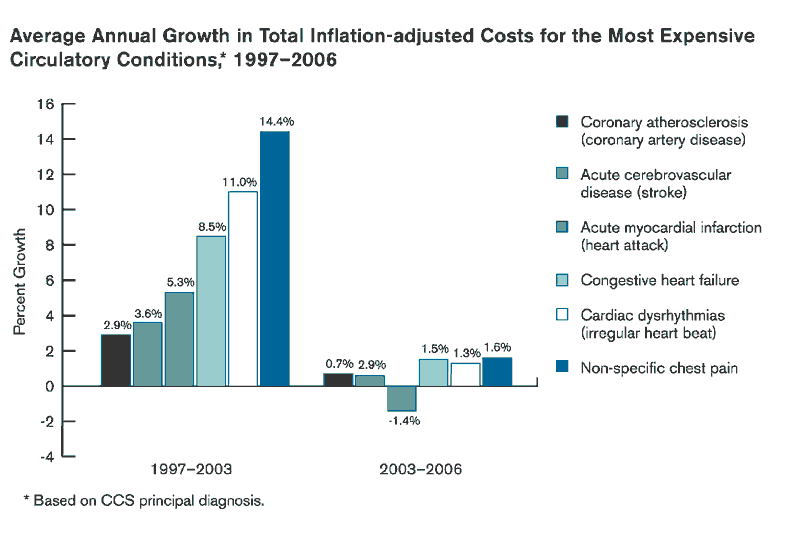
- The top six conditions by body system were responsible for 67 percent of the total costs for all hospital stays.
- In 2006, circulatory conditions accounted for the largest portion (23 percent) of hospitalization costs, or $79.5 billion, although they comprised only 16 percent of all stays.
- Other conditions responsible for large portions of hospital costs included musculoskeletal system and connective tissue conditions (12 percent), respiratory conditions (11 percent), digestive conditions (9 percent), nervous system conditions (7 percent), and pregnancy and childbirth (5 percent).
- The cost for hospitalizations related to circulatory conditions were large in 2006, with three-quarters of these costs concentrated in six specific circulatory conditions. However, the inflation-adjusted cost growth for stays with these six conditions slowed considerably in recent years.
- The slowdown in inflation-adjusted cost growth was attributable in part to an actual decrease in the number of discharges with these six circulatory conditions—a decline of almost 1 percent per year from 2003 to 2006 compared to a 1.3 percent average annual increase from 1997 to 2003.
- Slower increases in the inflation-adjusted cost per discharge contributed as well, with costs rising 1.4 percent per year between 2003 and 2006 compared to 4.5 percent per year between 1997 and 2003.
In general, longer lengths of stay are associated with higher average charges. While charges are generally more than the amount paid by payers for the hospitalization because of negotiated discounts, they can be used as a benchmark for comparing the costliness of different types of hospital stays.
- Overall, the average length of stay for any condition was 4.6 days, and the average charge was about $24,000 in 2006.
- The two conditions with the longest hospital stays for all patients regardless of age were related to infants—infant respiratory distress syndrome and premature birth and low birth weight.
- Infant respiratory distress syndrome and premature birth and low birth weight were also some of the most expensive conditions, with charges ranked second and fourth, respectively.
- Premature birth and low birth weight had an average length of stay of 26 days and infant respiratory distress syndrome of 23 days. The next longest length of stay was tuberculosis with 15 days.
- Conditions treated with expensive technology or requiring intensive care—including spinal cord injuries, heart valve disorders, and leukemias—had mean charges higher than expected based on their average length of stay (represented by the solid line in the graph).
- Spinal cord injuries had the highest mean charge of any condition, $113,200, but had a lower average length of stay (14 days) than infant respiratory distress syndrome (23 days) which had a mean charge of $106,500.
- Even though long lengths of stay can be costly, some conditions with the long lengths of stay had average charges that were lower than the expected average (represented by the solid line) in 2006. Typically, these conditions do not require expensive procedures as part of the hospitalization. Examples include schizophrenia and related disorders, affective disorders, and rehabilitation care.
(text version)

PRIORITY CONDITIONS
(text version)

(text version)

In 2006, there were 4.3 million maternal stays that resulted in a delivery.
- Vaginal births accounted for the majority of these stays (68 percent), but this was a significant decline since 1993 when vaginal births accounted for 78 percent of all deliveries.
- Both first time C-sections and repeat C-sections grew rapidly—by 55 percent and 98 percent, respectively—between 1998 and 2006.
- During the same period, the number of vaginal births after C-section (VBAC) decreased by 60 percent, from 156,000 to 62,000 cases.
Maternal Stays for C-Section and Vaginal Deliveries, 1993-2006
| |
TOTAL |
ALL DELIVERIES IN THOUSANDS |
| VAGINAL |
C-SECTION |
| TOTAL |
AFTER C-SECTION |
TOTAL |
FIRST TIME |
| 1993 |
3,774 |
2,958 |
138 |
817 |
518 |
| 1994 |
3,784 |
2,982 |
152 |
802 |
508 |
| 1995 |
3,768 |
2,977 |
157 |
791 |
507 |
| 1996 |
3,744 |
2,964 |
162 |
780 |
498 |
| 1997 |
3,809 |
3,010 |
160 |
799 |
506 |
| 1998 |
3,750 |
2,963 |
156 |
787 |
497 |
| 1999 |
3,840 |
2,993 |
145 |
848 |
532 |
| 2000 |
4,058 |
3,127 |
138 |
931 |
577 |
| 2001 |
3,980 |
2,986 |
112 |
995 |
600 |
| 2002 |
4,128 |
3,025 |
94 |
1,103 |
659 |
| 2003 |
4,052 |
2,882 |
76 |
1,170 |
695 |
| 2004 |
4,217 |
2,946 |
70 |
1,270 |
748 |
2005
| 4,192 |
2,889 |
62 |
1,303 |
756 |
| 2006 |
4,259 |
2,914 |
62 |
1,345 |
772 |
Overall, maternal complications are more commonly listed among women undergoing C-sections than among women who deliver vaginally. Some of these complications provide the rationale for performing C-sections.
- In 2006, the most common all-listed diagnosis for women who had a C-section procedure was a previous C-section. As more C-sections were performed and repeat C-sections were further encouraged, the share of all C-sections with this condition rose. At the same time, previous C-section complications fell as a share of vaginal deliveries.
- Complications due to hypertension, diabetes, and anemia increased among both C-section and vaginal deliveries between 1993 and 2006, but were present in a higher proportion of C-section than vaginal deliveries.
- Among C-section deliveries, the share complicated by hypertension rose from 10 percent to 13 percent, the share complicated by diabetes rose from 6 percent to 9 percent, and the share complicated by anemia rose from 3 percent to 8 percent.
- Umbilical cord complication was the only major complicating condition that occurred in a greater share of vaginal deliveries (24 percent) than of C-section deliveries (16 percent).
- The largest decline in delivery complications was for C-section deliveries involving fetopelvic disproportion. This condition complicated 23 percent (190,000) of C-section deliveries in 1993, but only 10 percent (136,000) of these deliveries in 2006.
- Other declines in complications for C-section deliveries included malposition/malpresentation (present in 23 percent of these deliveries in 1993 and 19 percent in 2006) and problems of the amniotic cavity (affecting 16 percent of C-section deliveries in 1993 and 13 percent in 2006).
- For vaginal deliveries, previous C-section complications affected a smaller share of deliveries (5 percent in 1993, but only 2 percent in 2006).
(text version)

- In 2006, 1.4 million infants were delivered by C-section and 2.9 million infants were delivered vaginally.
- The most common complication experienced by newborns was jaundice—affecting 26 percent of C-section delivered infants, but only 16 percent of vaginally delivered infants.
- Thirteen percent of infants delivered by C-section (183,400) were premature, compared with 6 percent of vaginally delivered infants (168,600).
- Post-birth respiratory problems not elsewhere classified, transitory tachypnea and respiratory distress syndrome were each diagnosed in 4 to 7 percent of infants delivered by C-section, but in just 1 to 3 percent of infants born by vaginal delivery.
- While feeding problems affected 4 percent of C-section infants, they affected only 2 percent of vaginally delivered infants.
- Two percent of infants born by C-section experienced neonatal hypoglycemia and "infant of a diabetic mother" syndrome, but only one percent of vaginally born infants experienced these complications.
- Cutaneous hemorrhages affected a greater share of vaginally born infants (1 percent) than of C-section delivered infants (0.5 percent).
- Fetal and newborn aspiration affected a greater share of C-section delivered infants (0.6 percent) than of vaginally delivered infants (0.4 percent).
(text version)

Between 1993 and 2006, the number of infant births grew from 3.8 million to 4.3 million. The number of vaginally delivered infants did not change significantly in this period. However, the number of infants born by C-section increased by 0.6 million, or 69 percent, at an annual rate of 4 percent.
- Several complications declined over time among infants born by C-section: fetal distress during labor (-12 percent annually), premature rupture of membrane affecting newborn (-5 percent annually), fetal and newborn aspiration (-2 percent annually), and exceptionally large baby (-2 percent annually).
- Among infants delivered by C-section, transitory tachypnea, heavy-for-dates infant, and respiratory distress syndrome diagnoses grew at about the same rate as C-section deliveries.
- Several complications grew more quickly than the 4 percent average annual growth in the number of C-section births, including post-birth respiratory problems not elsewhere classified (6 percent annually), "infant of a diabetic mother" syndrome (7 percent annually), jaundice (7 percent annually), and feeding problems not elsewhere classified (11 percent annually).
- Several complications grew among vaginally-delivered infants. These included feeding problems and jaundice, two diagnoses which also grew among C-section delivered infants.
- Diagnoses of fetal distress during labor, premature rupture of membrane affecting newborn, and fetal and newborn aspiration declined among vaginally delivered infants, as they did among C-section infants, between 1993 and 2006. Average annual decline for these diagnoses ranged from 17 percent (fetal distress during labor) to 3 percent (meconium aspiration).
(text version)
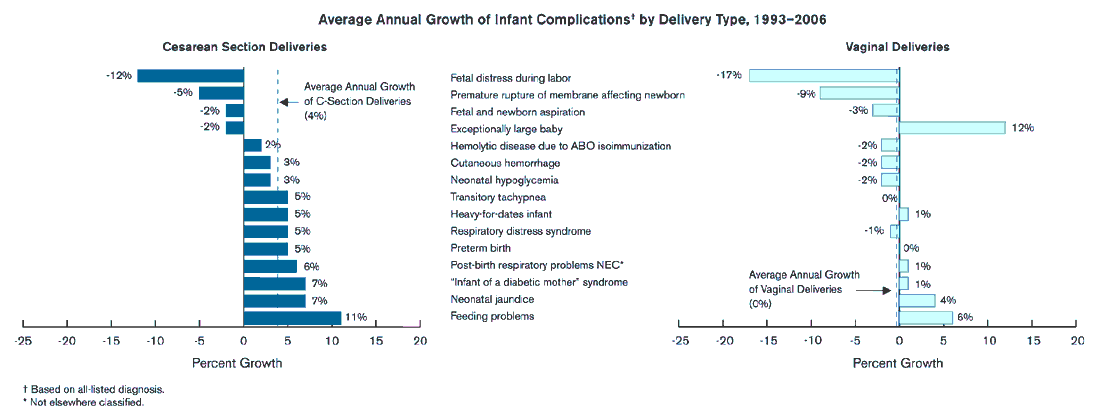
(text version)
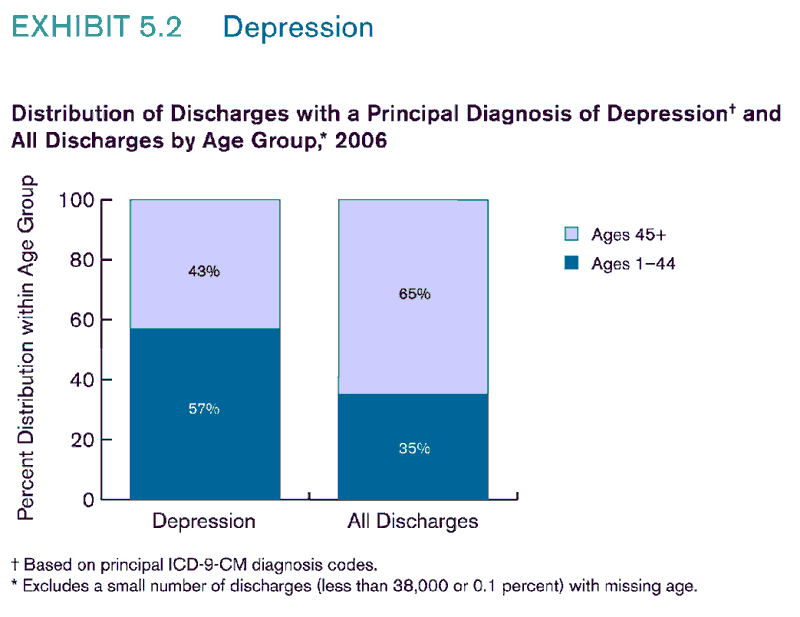
Depression, including major depressive disorder and dysthymic disorder (chronic, mild depression), is a leading cause of disability in the US, affecting about 18 million adults.1
- In 2006, there were 423,000 hospital stays with a principal diagnosis of depression.
- The average length of stay (ALOS) for depression was 6.4 days, compared to an ALOS of 4.6 days for all hospitalizations.
- About 45 percent of these discharges were admitted through the emergency department, a proportion similar to that of all discharges (44 percent).
- Younger patients comprised a larger share of hospital stays for depression (57 percent) than for overall hospitalizations (35 percent) in 2006.
Patients hospitalized for depression are often diagnosed with comorbid (or secondary) psychiatric and physical conditions.2
- Secondary mental health and substance abuse conditions were prevalent comorbidities for depression among both younger and older patients.
- The most common secondary diagnosis among individuals ages 1-44 hospitalized for depression was substance abuse, which was diagnosed in 36 percent of depression discharges in this age group. This was one and a half times the rate seen in older patients in the hospital for depression.
- Personality disorders were recorded more often as secondary conditions in depression discharges among younger patients (19 percent of their depression stays) than among patients 45 and older (13 percent of their depression stays).
- Alcohol related disorders, anxiety disorders, and suicide and intentional self-injury appeared as comorbid conditions in similar shares of depression discharges for both younger and older age groups. Altogether, one out of four discharges for depression was also diagnosed with an alcohol related disorder. More than one out of five patients hospitalized for depression also had an anxiety disorder or had a diagnosis of suicide attempt and intentional self-injury.
1Kessler RC, Chiu WT, Demler O, Walters EE. Prevalence, Severity, and Comorbidity of Twelve-month
DSM-IV Disorders in the National Comorbidity Survey Replication (NCS-R). 2005 Archives of General Psychiatry 62(6):617-27, 2005.
2Katon W. Clinical and Health Services Relationships between Major Depression, Depressive Symptoms, and General Medical Illness. Biological Psychiatry 54(3):216-226, 2003.
(text version)

Depression may be caused or exacerbated by multiple medical conditions. Because older adults often have multiple chronic conditions, they are particularly vulnerable to depression. Other chronic conditions add to the complexity of a depression diagnosis and can be responsible for under-diagnosis of this condition.3
- Overall, chronic physical (rather than psychiatric) conditions were more common among older age patients hospitalized for depression.
- Secondary diagnoses of disorders of hypertension, lipid metabolism, esophageal disorders, diabetes, and thyroid disorders were more likely in the older rather than the younger age groups hospitalized for depression.
3Hitchcock PN, Williams JW, Unützer J, et al. Depression and Comorbid Illness in Elderly Primary Care Patients: Impact on Multiple Domains of Health Status and Well-being. Annals of Family Medicine 2:555-562, 2004.
(text version)
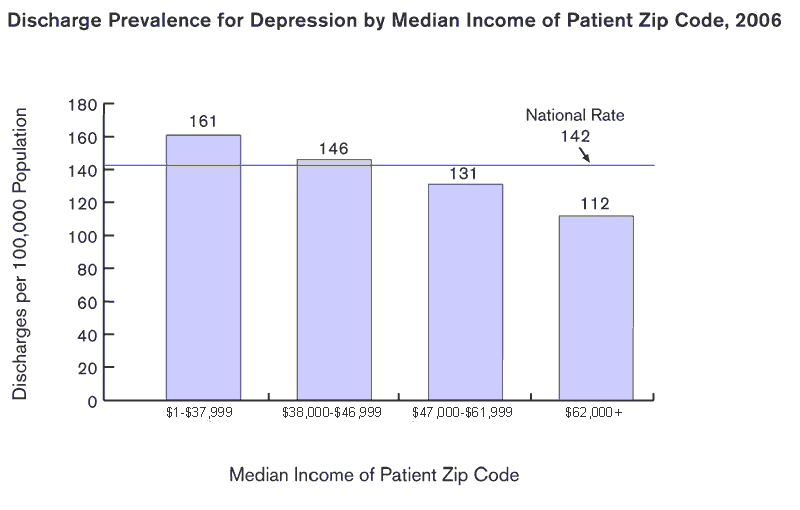
Nationwide, there were 142 discharges per 100,000 population for depression in 2006. The rate at which patients were hospitalized with a principal diagnosis of depression in 2006 varied by income4 and by region.
- Patients living in the lowest income communities tended to have higher rates of hospitalization for depression than persons in the highest income communities.4
- The rates of hospitalization for depression in communities with median incomes of $1-37,999 and $38,000-46,999 (161 and 146 per 100,000 persons, respectively) were 43 percent and 30 percent higher than the rates of depression hospitalization in the highest income communities.
4Daniel J, Honey W, Landen M, Marshall-Williams S, Chapman D, Lando J. Mental Health in the United States: Health Risk Behaviors and Conditions Among Persons with Depression—New Mexico, 2003. Center for Disease Control Morbidity and Mortality Weekly Report 54(39):989-91, October 7, 2005; Beard JR, Tracy M, Vlahov D, Galea S. Trajectory and Socioeconomic Predictors of Depression in a Prospective Study of Residents of New York City. Annals of Epidemiology 18(3):235-43, March 2008.
(text version)

- The West had the lowest rate of hospitalization for depression of any region—62 stays per 100,000 individuals.
- Compared to the West, discharges for depression occurred at twice the rate in the South, and around three times the rate in the Northeast and Midwest.
EXHIBIT 5.3 Cancer
- There were 1.45 million hospitalizations for cancer in 2006, a decline of almost ten percent from the 1.60 million discharges for cancer in 1997.
- During this period, the number of hospital stays for cancer changed considerably for certain diagnoses.
- The number of breast cancer hospitalizations changed the most, declining by 56,000 discharges, or 32 percent during this period. This decline is likely due to an increase in breast cancer procedures performed in outpatient settings.
- Hospitalizations for lung cancer—the cancer diagnosis which caused the greatest number of deaths in 20065 as well as the greatest number of hospital stays—also decreased substantially, with 21,000, or 10 percent, fewer stays for lung cancer in 2006 than 1997.
- Hospital stays for Hodgkin's disease, kidney cancer and liver cancer all increased by over 25 percent between 1997 and 2006.
- There were substantive decreases in the number of hospital stays for head and neck cancer (-17 percent), prostate cancer (-17 percent), bladder cancer (-20 percent), ovarian cancer (-30 percent), and cervical cancer (-39 percent).
5Cancer Facts and Figures, 2006. Online. 2006. American Cancer Society. http://www.cancer.org/downloads/STT/CAFF2006PWSecured.pdf. (link no longer available)
(text version)
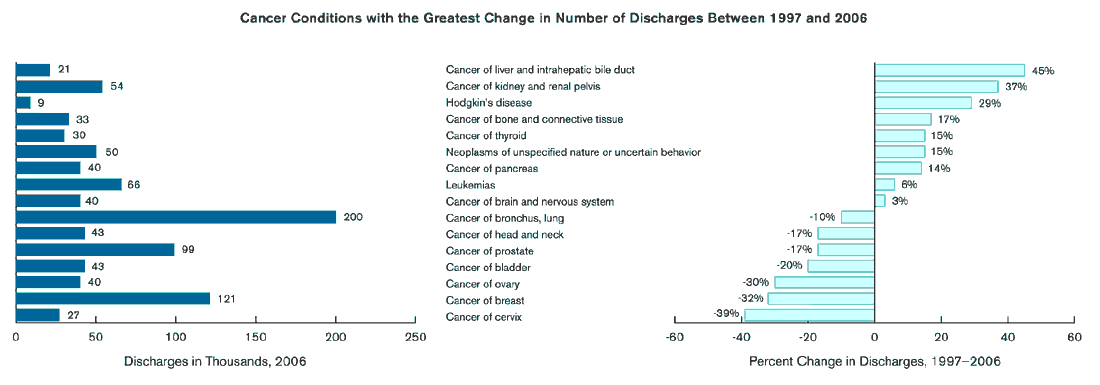
(text version)

- The prevalence of hospital stays for cancer was lowest in the West (422 discharges per 100,000 population) and highest in the Midwest (543 discharges per 100,000 population).
- Overall, lung cancer was the most common reason for a cancer-related hospital stay, with 200,000 discharges in 2006.
- Among men, lung cancer was the top reason for cancer-related hospitalizations, followed by prostate cancer.
- Among women hospitalization related to breast cancer was more likely while cancer stays for lung cancer ranked second.
- For both men and women, colon cancer was the third most frequent cause of a cancer-related hospital stay.
(text version)
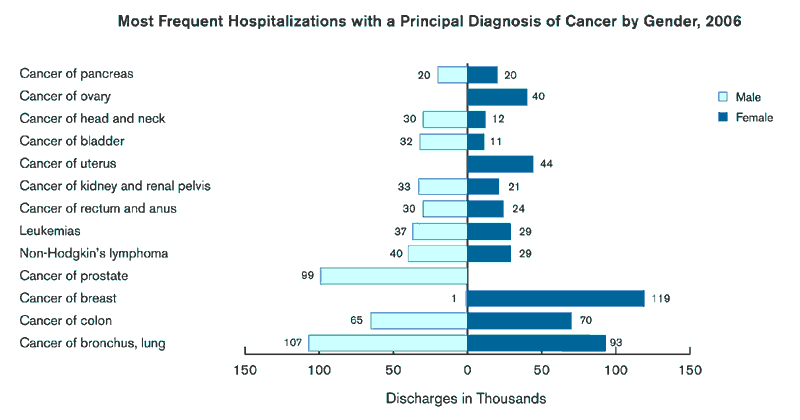
EXHIBIT 5.4 Asthma
(text version)
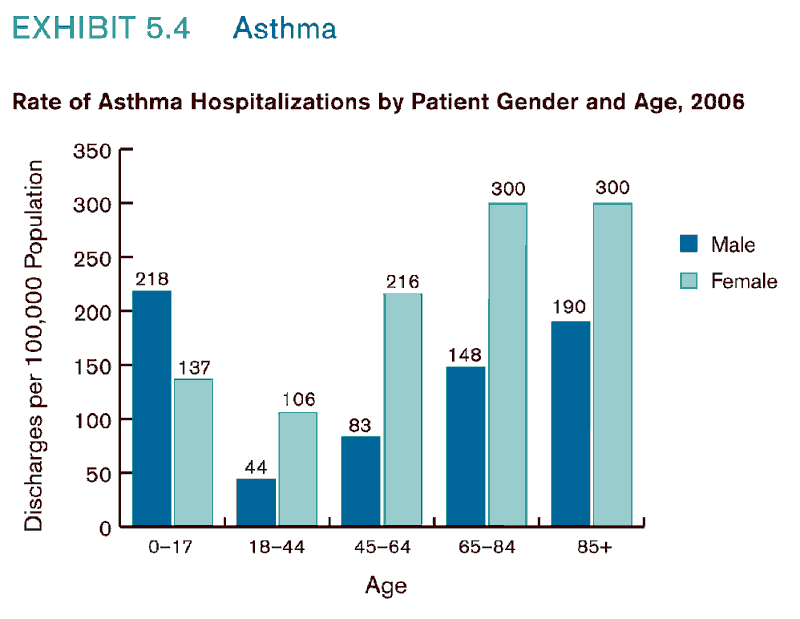
- There were 420,900 hospitalizations for asthma in 2006. Six out of every ten hospital stays were for women (256,100 stays) and almost one-third (133,700 stays) were for children under the age of 18.
- The rate of hospital stays for asthma was generally higher for females than males, except among children ages 0-17 years. Among males younger than 18 years of age, the rate of hospital stays for asthma was 1.6 times the rate among females of the same age.
(text version)
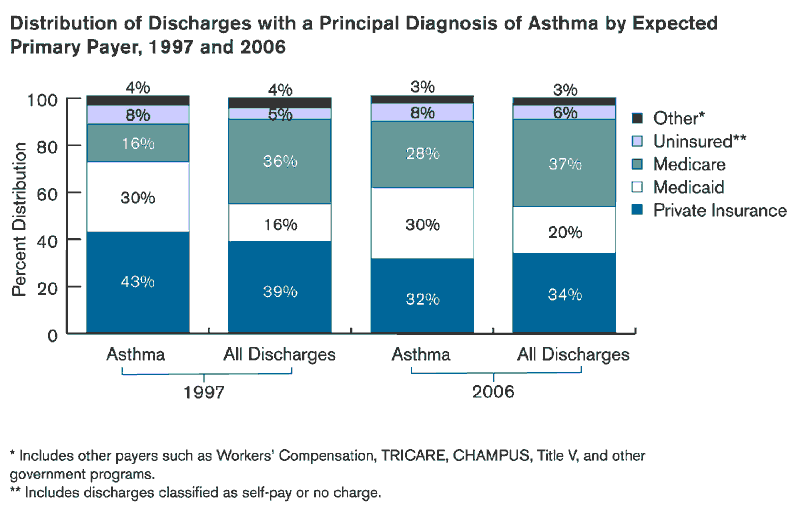
- In 2006, discharges with a principal diagnosis of asthma were more likely than all discharges to be covered by Medicaid or to be uninsured.
- The share of asthma discharges covered by Medicare increased by 12 percentage points between 1997 and 2006; the share covered by private insurance decreased by 11 percentage points in the same period.
(text version)

- The prevalence of hospital stays for a principal diagnosis of asthma was greater in the lowest income communities than it was in the highest income communities in all regions of the country.
- This higher prevalence of asthma-related stays in low-income communities was particularly distinct in the Northeast and Midwest regions where there were three times more discharges per 100,000 population in the lowest income communities compared with the highest income communities.
EXHIBIT 5.5 Arthritis
(text version)

- The number of hospitalizations with a principal diagnosis of arthritis more than doubled between 1993 and 2006—from 362,600 to 754,000.
- All of the increase in arthritis-related stays was due to osteoarthritis, which increased by 121 percent between 1993 (322,200 discharges) and 2006 (735,100 discharges). The number of stays for rheumatoid arthritis actually declined by 38 percent from 30,400 discharges in 1993 to 18,900 discharges in 2006.
(text version)
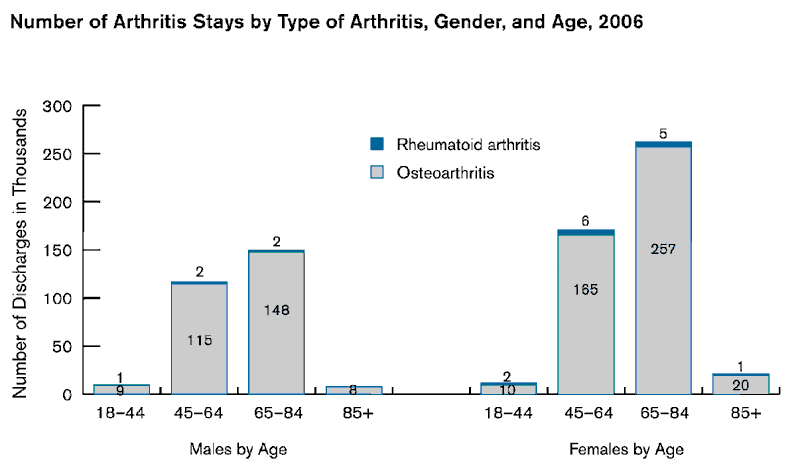
- The number of hospitalizations for all types of arthritis combined generally increased with age. In 2006, 93 percent of all arthritis stays were for persons ages 45-84.
- Hospitalizations for arthritis occurred in greater numbers for females than for males. Hospital stays for women accounted for 75 percent of stays with a principal diagnosis of rheumatoid arthritis and 62 percent of stays for osteoarthritis.
(text version)
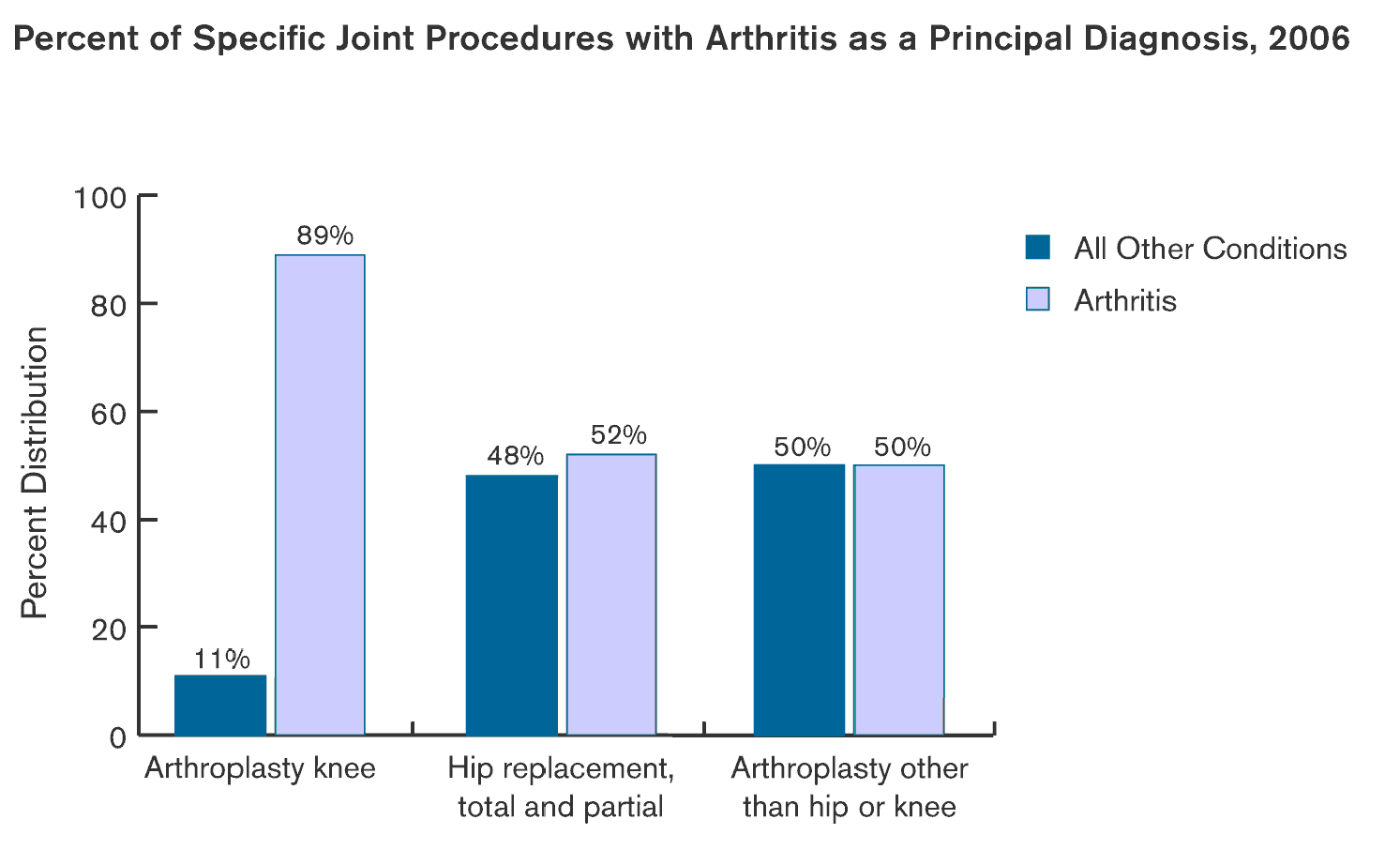
- Arthritis discharges accounted for a substantial proportion of the hospital stays for joint procedures in 2006.
- Of the 547,400 stays in which an arthroplasty of the knee was performed in 2006, nine out of every ten had a principal diagnosis of arthritis.
- In 2006, there were 369,400 stays for a hip replacement and 55,600 stays for arthroplasty other than for the hip or knee. Discharges with a principal diagnosis of arthritis accounted for about half of all stays for total and partial hip replacement (52 percent) and non-knee and non-hip arthroplasty (50 percent).
SOURCES AND METHODS
Unit of Analysis
The unit of analysis is the hospital stay rather than the patient. All discharges have been weighted to produce national estimates.
Coding Diagnoses and Procedures
Diagnoses and procedures associated with an inpatient hospitalization can be defined using several different medical condition classification systems. The following four systems are used within this report to identify specific diagnoses and procedures: International Classification of Diseases, 9th Revision, Clinical Modification (ICD-9-CM), Clinical Classifications Software (CCS), Diagnosis Related Groups (DRGs), and Major Diagnostic Categories (MDCs).
The most detailed system is the ICD-9-CM that contains over 13,600 detailed diagnoses and 3,700 detailed procedures. Each discharge record in the NIS is associated with one or more ICD-9-CM diagnosis code(s) and may contain one or more ICD-9-CM procedure code(s) if a procedure was performed during that hospitalization.
To make the number of ICD-9-CM diagnoses and procedures more manageable, AHRQ has designed the CCS tool that groups ICD-9-CM codes into about 280 diagnostic and 230 procedure categories. This software aggregates similar diagnoses or procedures into clinically meaningful categories. More information on CCS can be found online (http://www.hcup-us.ahrq.gov/toolssoftware/ccs/ccs.jsp). CCS codes are used extensively in this report to define groups of diagnoses and procedures for analysis. The CCS codes allow the reader to quickly and easily recognize patterns and trends in broad categories of hospital utilization.
In addition, diagnoses can also be grouped into DRGs. DRGs comprise a classification system that categorizes patients into groups, which are clinically coherent and homogeneous with respect to resource use. DRGs group patients according to diagnosis, type of treatment (procedures), age, and other relevant criteria. Each hospital stay has one DRG assigned to it. The Centers for Medicare and Medicaid Services (CMS) uses this classification system as a basis for Medicare payments for inpatient hospital stays.
DRGs, in turn, can be summarized into MDCs, which are broad groups of DRGs such as Diseases and Disorders of the Nervous System or Diseases and Disorders of the Eye. Each hospital stay has one DRG and one MDC assigned to it.
Exhibit Diagnoses and Procedures
Throughout this report, combinations of diagnostic and procedure codes are used to isolate specific conditions or procedures. These codes are defined below by exhibit number.
SECTION 2—INPATIENT HOSPITAL STAYS BY DIAGNOSIS
EXHIBIT 2.1
| Maternal CCS categories not listed on the exhibit table but included in total maternal discharges: |
| 176 |
Contraceptive and procreative management (birth control or helping with conception) |
| 177 |
Spontaneous abortion |
| 178 |
Induced abortion |
| 179 |
Postabortion complications (complications following abortion) |
| 180 |
Ectopic pregnancy (abdominal or tubal pregnancy) |
| 181 |
Other complications of pregnancy |
| 182 |
Hemorrhage during pregnancy, abruptio placenta, placenta previa (bleeding and placenta disorders during pregnancy) |
| 186 |
Diabetes or abnormal glucose tolerance complicating pregnancy, childbirth, or the puerperium (diabetes or high blood glucose during pregnancy) |
| 187 |
Malposition, malpresentation (breech birth and other disorders of baby's position during birth) |
| 188 |
Obstructed labor or fetopelvic disproportion |
| 194 |
Forceps delivery |
| 195 |
Other maternal complications of birth, puerperium affecting management of mother (other maternal complications of birth and period after childbirth) |
SECTION 3—INPATIENT HOSPITAL STAYS BY PROCEDURE
EXHIBIT 3.3
Two steps were used to define maternal and infant procedures. First, all maternal and newborn stays were identified using the following codes:
Maternal stays were identified using Major Diagnostic Code 14: Pregnancy, childbirth and the puerperium.
| Newborn stays were identified using the following CCS codes: |
| 218 |
Liveborn |
| 219 |
Short gestation, low birth weight, and fetal growth retardation |
| 220 |
Intrauterine hypoxia and birth asphyxia (lack of oxygen to baby in uterus or during birth) |
| 221 |
Respiratory distress syndrome |
| 222 |
Hemolytic jaundice and perinatal jaundice |
| 223 |
Birth trauma |
| 224 |
Other perinatal conditions (other conditions occurring around the time of birth) |
Second, maternal and newborn stays were examined for the following CCS all-listed procedures that were typically associated with maternal and infant stays:
| Maternal procedures: |
| 133 |
Episiotomy (surgical incision into the perineum and vagina to prevent traumatic tearing during delivery) |
| 134 |
Cesarean section |
| 135 |
Forceps, vacuum, and breech delivery |
| 136 |
Artificial rupture of membranes to assist delivery |
| 137 |
Other procedures to assist delivery |
| 138 |
Diagnostic amniocentesis (diagnostic sampling of the fluid in the amniotic sac) |
| 139 |
Fetal monitoring |
| 140 |
Repair of obstetric laceration |
| 141 |
Other therapeutic obstetrical procedures |
| Infant procedures: |
| 115 |
Circumcision |
| 220 |
Ophthalmologic and otologic diagnosis and treatment (vision and hearing diagnosis and treatment) |
| 228 |
Prophylactic vaccinations and inoculations |
SECTION 4—SPENDING FOR INPATIENT HOSPITAL STAYS
EXHIBIT 4.2
| Top 6 most expensive circulatory system diagnoses: |
| 100 |
Acute myocardial infarction (heart attack) |
| 101 |
Coronary atherosclerosis (coronary artery disease) |
| 102 |
Non-specific chest pain |
| 106 |
Cardiac dysrhythmias (irregular heart beat) |
| 108 |
Congestive heart failure |
| 109 |
Acute cerebrovascular disease (stroke) |
SECTION 5—PRIORITY CONDITIONS
EXHIBIT 5.1
| Childbirth DRG categories: |
| 370 |
Cesarean section with complications and comorbidities |
| 371 |
Cesarean section without complications and comorbidities |
| 372 |
Vaginal delivery with complicating diagnoses |
| 373 |
Vaginal delivery without complicating diagnoses |
| 374 |
Vaginal delivery with sterilization and/or dilation and curettage |
375
| Vaginal delivery with operating room procedure except sterilization and/or dilation and curettage |
| Within DRG 370-371 and 372-375, all-listed diagnoses were also subsetted using the following CCS diagnosis categories to produce repeat C-section and Vaginal Birth After C-section (VBAC): |
| 189 |
Previous C-section |
| Childbirth complication CCS categories: |
| 59 |
Deficiency and other anemia |
| 182 |
Hemorrhage during pregnancy, abruptio placenta, placenta previa (bleeding and placenta disorders during pregnancy) |
| 183 |
Hypertension complicating pregnancy, childbirth, and the puerperium (high blood pressure during pregnancy) |
| 184 |
Early or threatened labor |
| 186 |
Diabetes or abnormal glucose tolerance complicating pregnancy, childbirth, or the puerperium (diabetes or high blood glucose during pregnancy) |
| 187 |
Malposition, malpresentation (breech birth and other disorders of baby's position during birth) |
| 188 |
Obstructed labor or fetopelvic disproportion |
| 189 |
Previous C-section |
| 191 |
Polyhydramnios and other problems of amniotic cavity (excess amniotic fluid and other problems of amniotic cavity) |
| 192 |
Umbilical cord complication |
| Infant delivery type ICD-9-CM codes: |
| V30-V39 |
Liveborn infants |
| .00 |
delivered without mention of cesarean delivery (vaginal delivery) |
| .01 |
delivered by cesarean delivery |
Infant complication ICD-9-CM codes (selected ICD-9-CM codes were grouped together for graphic display):
| Preterm birth: |
| 765.0 |
Extreme immaturity |
| 765.1 |
Other preterm infant |
| Meconium aspiration: |
| 770.1 |
Fetal and newborn aspiration |
| Post-birth respiratory problems: |
| 770.8 |
Other respiratory problems after birth |
| Neonatal jaundice: |
| 774.2 |
Neonatal jaundice associated with preterm delivery |
| 774.6 |
Unspecified fetal and neonatal jaundice |
| Other conditions listed separately: |
| 761.1 |
Premature rupture of membrane affecting newborn |
| 766.0 |
Exceptionally large baby |
| 766.1 |
Heavy-for-dates infant |
| 768.3 |
Fetal distress during labor |
| 769 |
Respiratory distress syndrome |
| 770.6 |
Transitory tachypnea |
| 772.6 |
Cutaneous hemorrhage |
| 773.1 |
Hemolytic disease due to ABO isoimmunization |
| 775.0 |
"Infant of a diabetic mother" syndrome |
| 775.6 |
Neonatal hypoglycemia |
| 779.3 |
Feeding problems |
EXHIBIT 5.2
| Depression ICD-9-CM codes: |
| 293.83 |
Mood disorder in conditions classified elsewhere-Transient organic psychotic condition, depressive type |
| 296.2 |
Major depressive disorder, single episode |
| 296.3 |
Major depressive disorder, recurrent episode |
| 300.4 |
Dysthymic disorder |
| 311 |
Depressive disorder, not elsewhere classified |
| Other Mental Health and Substance Abuse Secondary Conditions were identified in the following CCS-MHSA categories that were created using the CCS-MHSA tool: |
| 650 |
Adjustment disorders |
| 651 |
Anxiety disorders |
| 652 |
Attention-deficit, conduct, and disruptive behavior disorders |
| 653 |
Delirium, dementia, and amnestic and other cognitive disorders |
| 654 |
Developmental disorders |
| 655 |
Disorders usually diagnosed in infancy, childhood, or adolescence |
| 656 |
Impulse control disorders, not elsewhere classified |
| 657 |
Mood disorders |
| 658 |
Personality disorders |
| 659 |
Schizophrenia and other psychotic disorders |
| 660 |
Alcohol-related disorders |
| 661 |
Substance-related disorders |
EXHIBIT 5.3
| Cancer CCS categories: |
| 11 |
Cancer of head and neck |
| 12 |
Cancer of esophagus |
| 13 |
Cancer of stomach |
| 14 |
Cancer of the colon |
| 15 |
Cancer of rectum and anus |
| 16 |
Cancer of liver and intrahepatic bile duct |
| 17 |
Cancer of pancreas |
| 18 |
Cancer of GI organs and peritoneum |
| 19 |
Cancer of bronchus, lung |
| 20 |
Cancer, other respiratory and intrathoracic |
| 21 |
Cancer of bone and connective tissue |
| 22 |
Melanomas of skin |
| 23 |
Other non-epithelial cancer of skin |
| 24 |
Cancer of breast |
| 25 |
Cancer of uterus |
| 26 |
Cancer of cervix |
| 27 |
Cancer of ovary |
| 28 |
Cancer of other female genital organs |
| 29 |
Cancer of prostate |
| 30 |
Cancer of testis |
| 31 |
Cancer of other male genital organs |
| 32 |
Cancer of bladder |
| 33 |
Cancer of kidney and renal pelvis |
| 34 |
Cancer of other urinary organs |
| 35 |
Cancer of brain and nervous system |
| 36 |
Cancer of thyroid |
| 37 |
Hodgkin's disease |
| 38 |
Non-Hodgkin's lymphoma |
| 39 |
Leukemias |
| 40 |
Multiple myeloma |
| 41 |
Cancer, other primary |
| 43 |
Malignant neoplasm without specification of site |
| 44 |
Neoplasms of unspecified nature or uncertain behavior |
| ** |
Multiple cancer sites |
| ** |
No specific sites listed |
| **CCS Diagnosis Code 42 ‘Secondary malignancies’ and 45 ‘Maintenance chemotherapy, radiotherapy’ were reclassified and discharges were assigned to a specific cancer category listed as a secondary condition. If no secondary cancer diagnosis was listed, then discharges for CCS diagnosis codes 42 and 45 were counted as ‘No specific sites listed.’ If multiple secondary CCS diagnoses were listed, then CCS diagnosis codes 42 and 45 discharges were counted as ‘Multiple cancer sites.’ |
EXHIBIT 5.4
| Asthma CCS category: |
| 128 |
Asthma |
EXHIBIT 5.5
| Arthritis CCS categories: |
| 202 |
Rheumatoid arthritis and related disease |
| 203 |
Osteoarthritis |
DEFINITIONS
Adjusted for general inflation
Costs can be adjusted for economy-wide inflation by removing increases that reflect the effect of changing average prices for the same goods and services. In this report, the U.S. Bureau of Economic Analysis Gross Domestic Product Price Index is used to remove economy-wide inflation. Additional inflation that is specific to the hospital sector is not removed in this calculation.
Admission source
Admission source indicates where the patient was located prior to admission to the hospital.
Routine admission: Patient was admitted to the hospital from home, via physician or clinic referral, or due to birth (i.e., newborns). It does not include patients who were admitted from the emergency department or any other healthcare facility.
Emergency department admission: Patient was admitted to the hospital through the emergency department.
Long-term healthcare facility admission: Patient was admitted to the hospital from a long-term healthcare facility.
Other hospital admission: Patient was admitted to the hospital from another hospital.
Other admissions: Patient was admitted through court/law enforcement or other admission sources.
Aggregate costs
Aggregate costs are the sum of all costs for all hospital stays.
Charges
Hospital charges reflect the amount the hospital billed for the entire hospital stay and do not include professional (physician) fees. The charge is generally more than the amount paid to the hospital by payers for the hospitalization and is also generally far more than what it costs hospitals to provide care.
Community hospitals
HCUP is based on data from community hospitals, defined as short-term, non-Federal, general and other hospitals, excluding hospital units of other institutions (e.g., prisons). Community hospitals (and HCUP data) include OB-GYN, ENT, orthopedic, cancer, pediatric, public, and academic medical hospitals. They exclude hospitals whose main focus is long-term care, psychiatric, and alcoholism and chemical dependency treatment, although discharges from these types of units that are part of community hospitals are included.
Costs
Costs are derived from total hospital charges using cost-to-charge ratios based on hospital accounting reports from the Centers for Medicare and Medicaid Services (CMS). Costs will tend to reflect the actual costs to produce hospital services, while charges represent what the hospital billed for the care. For each hospital, a hospital-wide cost-to-charge ratio is used to transform charges into costs.
Diagnoses
Principal diagnoses: The conditions established after study to be chiefly responsible for the patient's admission to the hospital.
All-listed diagnoses: The principal diagnosis plus secondary conditions.
Discharge
Discharge refers to the hospital stay. The unit of analysis for HCUP data is the hospital discharge, not a person or patient. This means that a person who is admitted to the hospital multiple times in one year will be counted each time as a separate discharge from the hospital.
Discharge status
Discharge status indicates the disposition of the patient at the time of discharge from the hospital, and includes the following six categories: routine (to home), transfer to another short-term hospital, other transfers (including skilled nursing facility, intermediate care, rehabilitation care, swing bed, and another type of facility such as a nursing home), home healthcare, against medical advice (AMA), or died in the hospital.
Discharge per 1,000 population
Discharges per 1,000 population is the hospital discharge rate of a particular procedure, diagnosis, or event per 1,000 individuals. This measure indicates the prevalence of hospitalizations, procedures or diagnoses within the population.
In-hospital deaths
In-hospital deaths refer to hospitalizations in which the patient died during his or her hospital stay.
Infant discharges
Infant discharges are hospital stays during which a child is born.
Length of stay
Length of stay is the number of nights the patient remained in the hospital for his or her stay. A patient admitted and discharged on the same day has a length of stay equal to 0.
Maternal discharges
Maternal discharges are hospital stays for females who are pregnant or gave birth.
Median income
Median income is the median household income of the patient's ZIP Code of residence. This is a proxy measure of a patient's socioeconomic status.
Metropolitan location
Metropolitan location indicates that the hospital is in a metropolitan area ("urban") rather than a non-metropolitan area ("rural"), as defined by the American Hospital Association (AHA) Annual Survey, using the 1993 U.S. Office of Management and Budget definition.
Ownership/control
Ownership/control was obtained from the American Hospital Association (AHA) Annual Survey of Hospitals and includes categories for government non-Federal (public), private not-for-profit (voluntary), and private investor-owned (proprietary). These types of hospitals tend to have different missions and different responses to government regulations and policies.
Patient age
Patient age in years, calculated based on the patient's date of birth and admission date to the hospital.
Payers
Payer is the expected payer for the hospital stay. To make coding uniform across all HCUP data sources, payer combines detailed categories into more general groups:
Medicare includes fee-for-service and managed care Medicare patients.
Medicaid includes fee-for-service and managed care Medicaid patients. Patients covered by the State Children's Health Insurance Program (SCHIP) may be included here. Because most state data do not identify SCHIP patients specifically, it is not possible to present this information separately.
Private insurance includes Blue Cross, commercial carriers, and private HMOs and PPOs.
Other includes Worker's Compensation, TRICARE/CHAMPUS, CHAMPVA, Title V, and other government programs.
Uninsured includes an insurance status of "self-pay" and "no charge."
When more than one payer is listed for a hospital discharge, the first-listed payer is used.
Procedures
Principal procedure is the procedure that was performed for definitive treatment rather than one performed for diagnostic or exploratory purposes (i.e., the procedure that was necessary to take care of a complication). If two procedures appear to meet this definition, the procedure most related to the principal diagnosis is selected as the principal procedure.
All-listed procedures include all procedures performed during the hospital stay.
Region
Region is one of the four regions defined by the U.S. Bureau of the Census: Northeast, Midwest, South, and West.
Northeast is defined as Connecticut, Maine, Massachusetts, New Hampshire, New Jersey, New York, Pennsylvania, Rhode Island, and Vermont.
Midwest is defined as Illinois, Indiana, Iowa, Kansas, Michigan, Minnesota, Missouri, Nebraska, North Dakota, Ohio, South Dakota, and Wisconsin.
South is defined as Alabama, Arkansas, Delaware, District of Columbia, Florida, Georgia, Kentucky, Louisiana, Maryland, Mississippi, North Carolina, Oklahoma, South Carolina, Tennessee, Texas, Virginia, and West Virginia.
West is defined as Alaska, Arizona, California, Colorado, Hawaii, Idaho, Montana, Nevada, New Mexico, Oregon, Utah, Washington, and Wyoming.
Not all states participate in HCUP, so not all states will be present in HCUP data. However, the statistics have been weighted to represent the entire U.S.
Stays
The unit of analysis for HCUP data is the hospital stay (i.e., the hospital discharge), not a person or patient. This means that a person who is admitted to the hospital multiple times in one year will be counted each time as a separate "discharge" from the hospital.
FOR MORE INFORMATION
HCUP Background Information
For a detailed description of HCUP, information on the design of the NIS, and methods to calculate estimates, please refer to the following publications:
Steiner C, Elixhauser A, Schnaier J. The Healthcare Cost and Utilization Project: An Overview. Effective Clinical Practice 5(3):143–51, 2002.
Design of the HCUP Nationwide Inpatient Sample, 2005. Online. June 13, 2007. U.S. Agency for Healthcare Research and Quality. http://www.hcup-us.ahrq.gov/db/nation/nis/reports/NIS_2005_Design_Report.pdf.
Houchens R, Elixhauser A. Final Report on Calculating Nationwide Inpatient Sample (NIS) Variances, 2001. HCUP Methods Series Report #2003-2. Online. June 2005 (revised June 6, 2005). U.S. Agency for Healthcare Research and Quality.
http://www.hcup-us.ahrq.gov/reports/methods/2003_02.pdf.
Houchens RL, Elixhauser A. Using the HCUP Nationwide Inpatient Sample to Estimate Trends. (Updated for 1988-2004). HCUP Methods Series Report #2006-05. Online. August 18, 2006. U.S. Agency for Healthcare Research and Quality.
http://www.hcup-us.ahrq.gov/reports/methods/2006_05_NISTrendsReport_1988-2004.pdf.
HCUP Statistics and Website
Many of the statistics presented here were taken directly from HCUPnet. For additional HCUP statistics, visit HCUPnet, our interactive query system at https://datatools.ahrq.gov/hcupnet.
Technical Assistance
For Technical Assistance with HCUP Products:
E-mail: hcup@ahrq.gov
Phone: 1-866-290-HCUP
ACKNOWLEDGMENTS
Thanks to Eva Witt and Nils Nordstrand at Thomson Reuters for their programming support; Anne Pfuntner at Thomson Reuters for her assistance in the preparation of tables and text; Cheryl Kassed, also at Thomson Reuters, for her editorial assistance; and Robyn Short of The Madison Design Group for her creative design and layout of the report. This document draws from and updates previously published HCUP Fact Books and Statistical Briefs, which can be found at http://www.hcup-us.ahrq.gov/reports.jsp and
http://www.hcup-us.ahrq.gov/reports/statbriefs/sbtopic.jsp.
RECOMMENDED CITATION
Levit K (Thomson Reuters), Stranges E (Thomson Reuters), Ryan K (Thomson Reuters), Elixhauser A (AHRQ). HCUP Facts and Figures, 2006: Statistics on Hospital-based Care in the United States. Rockville, MD: Agency for Healthcare Research and Quality, 2008. http://www.hcup-us.ahrq.gov/reports.jsp
![]()



































